.

 HECTOR COWAN.
HECTOR COWAN.Princeton.
AMERICAN FOOTBALL
BY
WALTER CAMP
WITH THIRTY-ONE PORTRAITS
NEW YORK
HARPER & BROTHERS, FRANKLIN SQUARE
1891
Copyright, 1891, by Harper & Brothers.
All rights reserved.
PREFACE.
The progress of the sport of football in this country, and a corresponding growth of inquiry as to the methods adopted by experienced teams, have prompted the publication of this book. Should any of the suggestions herein contained conduce to the further popularity of the game, the object of the writer will be attained.
CONTENTS.
PAGE
English and American Rugby 1
End Rusher 23
The Tackle 39
The Guard 53
The Centre, or Snap-back 67
The Quarter-back 79
The Half-back and Back 91
Signals 115
Training 131
A Chapter for Spectators 165
LIST OF PORTRAITS.
[P. stands for Princeton, Y. for Yale, and H. for Harvard.]
| Hector Cowan, p | Frontispiece. | |
| Harry W. Beecher, y | Facing p. | 4 |
| Henry C. Lamar, p | " | 8 |
| D. S. Dean, h | " | 12 |
| E. L. Richards, Jr., y | " | 16 |
| W. A. Brooks, h | " | 20 |
| R. S. Channing, p | " | 28 |
| L. K. Hull, y | " | 32 |
| E. A. Poe, p | " | 36 |
| Everett J. Lake, h | " | 44 |
| Wyllys Terry, y | " | 48 |
| B. W. Trafford, h | " | 56 |
| T. L. McClung, y | " | 60 |
| V. M. Harding, h | " | 64 |
| Jesse Riggs, p | " | 72 |
| W. H. Corbin, y | " | 76 |
| [Pg viii] | ||
| Alexander Moffatt, p | " | 84 |
| Ralph Warren, p | " | 88 |
| John Corbett, h | " | 96 |
| W. Bull, y | " | 100 |
| Knowlton L. Ames, p | " | 104 |
| W. C. Rhodes, y | " | 112 |
| P. D. Trafford, h | " | 120 |
| R. Hodge, p | " | 124 |
| H. H. Knapp, y | " | 128 |
| A. J. Cumnock, h | " | 136 |
| Jeremiah S. Black, p | " | 140 |
| C. O. Gill, y | " | 150 |
| E. C. Peace, p | " | 156 |
| W. Heffelfinger, y | " | 160 |
| R. M. Appleton, h | " | 168 |
ENGLISH AND AMERICAN RUGBY
AMERICAN FOOTBALL.
Rugby football—for it is from the Rugby Union Rules that our American Intercollegiate game was derived—dates its present era of popularity from the formation in England, in 1871, of a union of some score of clubs. Nearly ten years before this there had been an attempt made to unite the various diverging football factions under a common set of laws; but this proved a failure, and the styles of play became farther and farther apart. Of the Association game one can say but little as regards its American following. It is[Pg 4] quite extensively played in this country, but more by those who have themselves played it in Great Britain than by native-born Americans. Its popularity is extending, and at some day it will very likely become as well understood in this country as the derived Rugby is to-day. Its essential characteristic is, that it is played with the feet, in distinction from the Rugby, in which the ball may be carried in the hands.
To revert to the Rugby Union. Years before the formation of this association the game was played by sides almost unlimited in numbers. One of the favorite school matches was "Sixth form against all the rest of the school." Twenty on a side, however, became the ruling number; but this was, after a time, replaced by fifteens, as the days of twenties proved only shoving matches. With the reduction in numbers came increased running and an added interest. This change to fifteens was made in 1877, at the request of Scotland. At once there followed a more open style of play, and before long short passing became common. In 1882 the Oxford team instituted the long low pass to the open, and by the use of it remained undefeated for three seasons.
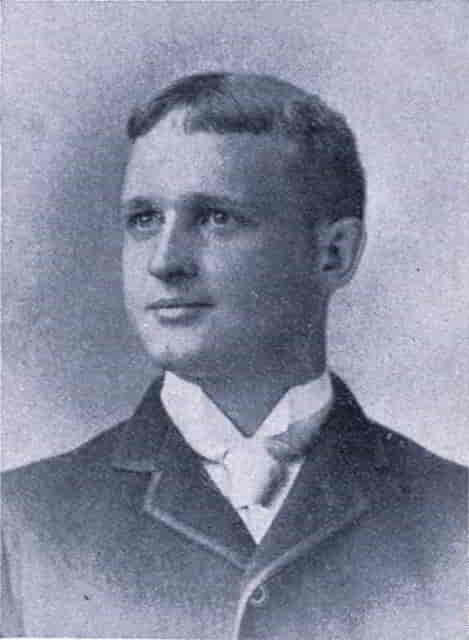 HARRY W. BEECHER.
HARRY W. BEECHER.Yale.
After the decrease to fifteen men the number of three-quarter-backs, who really represent our American half-backs, was increased from one to two, and two full-backs were played. A little later British captains put another full-back up into the three-quarter line, playing with only one full-back.
The Englishmen also play two men whom they call half-backs, but whose duties are like those of our quarter-back, for they seize the ball when it comes out[Pg 6] of the scrimmage and pass it to a three-quarter for a run.
Nine men is the usual number for an English rush line, although a captain will sometimes take his ninth rusher back as a fourth three-quarter-back. There is much discussion as to when this should be done. The captain selects his men much as we do in America, and he is generally himself a player of some position behind the line, centre three-quarter being preferred. The opening play in an English Rugby game is, as a rule, a high kick well followed up. If one will bear in mind that the half-backs are, like our quarter, the ones to seize the ball when it emerges from a scrimmage and pass it to the three-quarters, he will gain some idea of the character of the English method. He should understand, however, that the English half-back is obliged to look out sharply for the ball, because[Pg 7] it comes out by chance and at random, and not directly as in our game, where the quarter can usually expect to receive the ball without trouble from the snap-back.
The forwards in an English match endeavor, when a scrimmage occurs, by kicking and pushing to drive the ball in the direction of their opponents' goal line, and they become extremely expert in the use of their feet. There are two umpires, whose duty it is to make claims (which they do by raising their flags), and a referee, who allows or disallows these claims. The penalty for fouls, which was at first only a down, is now in many cases a free kick.
The American game, it must be remembered, came from the Rugby Union in 1875, and not from the Rugby Union of to-day, although the changes in the English game have been by no manner[Pg 8] of means commensurate with those made on this side the water. Being bound by no traditions, and having seen no play, the American took the English rules for a starting-point, and almost immediately proceeded to add and subtract, according to what seemed his pressing needs. And they were many. A favored few, whose intercourse with Canadian players had given them some of the English ideas, were able to explain the knotty points to a small degree, but not enough to really assist the mass of uninitiated players to an understanding. Misinterpretations were so numerous as to render satisfactory rulings almost out of the question and explanatory legislation imperative. In the autumn of 1876 the first game under Rugby rules between American colleges was played at New Haven, and before another was attempted a convention had tried its hand at correcting the weak points, as they appeared to the minds of the legislators, in the Rugby Union Rules.
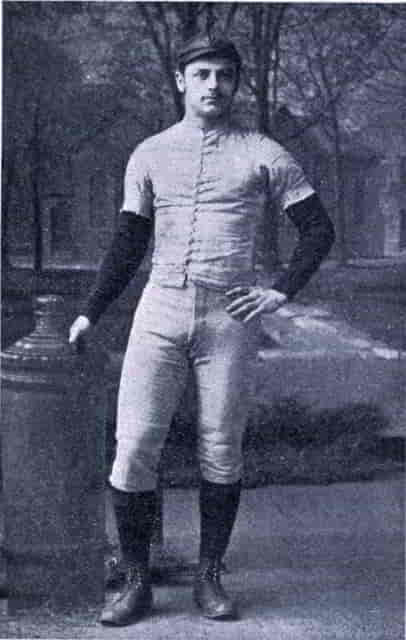 HENRY C. LAMAR.
HENRY C. LAMAR.Princeton.
The feature of the American game in distinction from the English is, just as it was within a year from the time of the adoption of the sport, the outlet of the scrimmage.
In this lies the backbone to which the entire body of American football is attached. The English half-backs stand outside the scrimmage, and when the ball pops out it is their duty to seize it and pass it out to a three-quarter, who runs with it. The American quarter-back stands behind the scrimmage and gives a signal, immediately after which he knows the ball will come directly into his hands to be passed for a run or a kick. What is, therefore, in the English game a matter of considerable chance is "cut-and-dried" in the American[Pg 10] game; and the element of chance being eliminated, opportunity is given for the display in the latter game of far more skill in the development of brilliant plays and carefully planned man[oe]uvres.
The Americans started with the English scrimmage, kicked at the ball, and pushed and scrambled for a season, until it was discovered that a very clever manifestation of the play was to let the opponents do the kicking—in fact, to leave an opening at the proper moment through which the ball would come, and a man a few feet behind this opening could always get the ball and pass it while the men who kicked it were still entangled in the scrimmage. After a little of this, no one was anxious to kick the ball through, and the rushers began to roll the ball sidewise along between the lines. Then almost immediately it was discovered that a man could snap[Pg 11] the ball backwards with his toe, and the American outlet was installed.
At first the play was crude in the extreme, but even in its earliest stages it proved distinctly more satisfactory to both player and spectator than the kicking and shoving which marked the English method.
The same man did not always snap the ball back as he does now, but any one of the rushers would do it upon occasion. The men did not preserve their relative positions in the line, and any one of the men behind the line would act as a quarter-back. Such a condition of affairs could not, however, last long where intercollegiate rivalry proved such an incentive to the perfection of play, and the positions of centre-rush or snap-back and quarter-back became the most distinctive of any upon the field. The centre-rush at that time was selected[Pg 12] more for his agility, strange to say, than for his weight and strength; but in case he was a light man he was always flanked by two heavy guards. One season's play convinced all captains that the centre section of the forward line must be heavy, and if any light-weights were to be used among the rushers they should be near the wings.
Quarter-back has, from the very outset, been a position in which a small man can be used to great advantage. The half-backs and backs have usually been men of speed coupled with skill as kickers.
The number originally adopted for matches in this country was eleven on a side. From some silly notion that it would increase the skill displayed, this number was changed to fifteen, although the Englishmen were moving in the other direction by reducing their numbers from twenties to fifteens. A year or two of fifteen on a side drove the American players back to elevens, and there the number has rested.
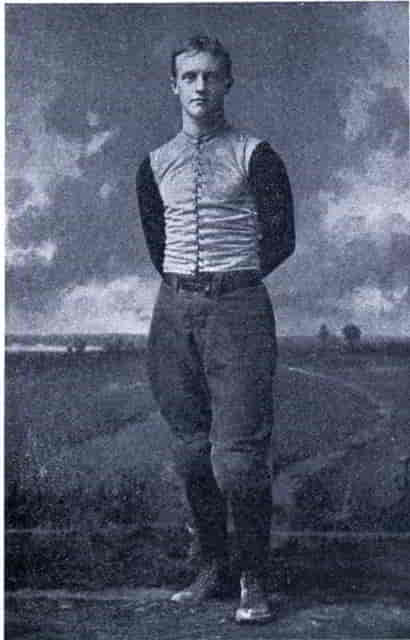 D. S. DEAN.
D. S. DEAN.Harvard.
In the early days of the sport, while the players individually were courageous, the team play was cowardly; that is, the tacticians were so taken up with a study of defence—how to protect the goal—that the attack was weak. The direct result of this was to place too few men in the forward line and too many behind it. If to-day we were to revert to fifteen on a side, there is little doubt that we should throw eleven of them up into the rush line, and upon occasion even twelve. We now realize that the best defence does not consist in planning how to stop a man after he has obtained a fair start towards the goal, but in throwing all available force up against him before he can get free of the forward line. The only way to effectively[Pg 14] defeat this aggressive defence is by means of skilled kicking. It is possible with really good kickers to throw a team playing in this fashion into disorder by well-placed and long punting, followed up most sharply; but it requires nerve and an unfailing accuracy of aim and judgment.
It is only a few years ago that it required considerable argument to convince a captain that he could with safety send one of his halves up into the forward line when his opponents had the ball; but it will take better kicking than is exhibited in most of the championship matches to frighten that half-back out of the line now. Even the quarter was wont upon occasion to drop back among the halves and assist them rather than the rushers.
All the tendency for the last two years has been towards diminishing the[Pg 15] number of men held in reserve, as it were, behind the line, and increasing by this means the crushing force by which the forwards might check either runner or kicker before his play could be executed.
Should the English ever adopt an outlet for their scrimmage, making the play as direct as is ours, their men would gravitate to the forward line as rapidly as have our players.
Next to the difference in scrimmage outlet between our game and that of the British stands a much more recent development, which we call interference. This is the assistance given to a runner by a companion or companions who go before him and break a path for him or shoulder off would-be tacklers. This, to the Englishman, would be the most detestable kind of off-side play, and not tolerated for an instant upon any field in the United Kingdom.[Pg 16]
Even into this the Americans did not plunge suddenly, but rather little by little they stepped in, until it was necessary to do one of two things—either legalize what was being tacitly consented to, or penalize it heavily. The result was that it was legalized. With this concession, though, there went a certain condition which gained a measure of confidence for the new ruling.
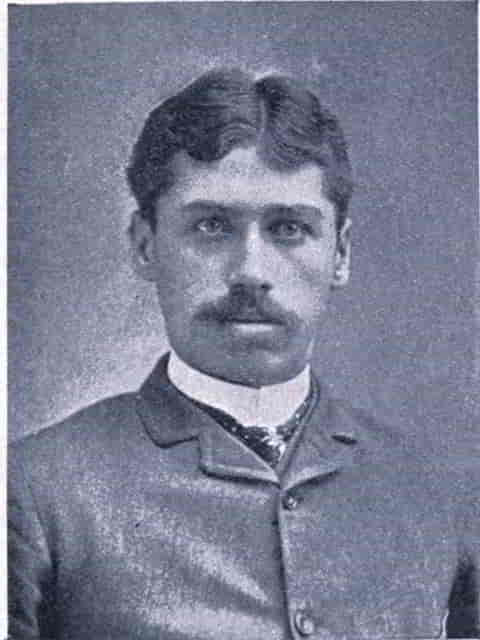 E. L. RICHARDS.
E. L. RICHARDS.Yale.
To understand just how this state of affairs above mentioned came about one should know that, in the attempt to block opponents when the quarter-back was receiving and passing the ball, the forwards fell into the habit of extending their arms horizontally from the shoulder, as by this method each man could cover more space. For a number of years this went on without detriment to the sport in any way, but after a time there was more or less complaint of holding in the line, and it was ruled that a man must not change his position after the ball was snapped, nor bend his arms about an opponent at such a time. Unfortunately the referee (for at this stage of the game there was no umpire) could not watch the ball and the players with sufficient care to enforce this ruling, and the temper of the players suffered accordingly. It is always the case when a rule is not enforced unflinchingly, no matter from what cause, that both sides suffer, and the tendency always is towards devising additional infringements. The additional infringement in this instance was even worse than could have been foreseen; for, not content with simply blocking or even holding an opponent until the quarter should have passed the ball in safety, the players in the forward line saw an opportunity for going a step farther,[Pg 18] and actually began the practice of seizing an opponent long after the ball had been played, and dragging him out of the way of the running half-back. In the thick of the rush line this was frequently possible without risk of discovery by the referee; and, emboldened by successes of this kind, men would reach out even in the open, and drag back a struggling tackler just as he was about to lay his hands upon the runner. It was this state of affairs which brought up the question, "How much should a comrade be allowed to aid the runner?"
American football legislators answered this question satisfactorily, after long discussion, by determining that the runner might be assisted to any extent, provided the assistant did not use his hands or arms in performing this office. The first result of this was to lower the arms[Pg 19] of the rushers when lined up, and, in spite of some forebodings, this proved really a benefit to the game. The second result has been to perfect a system of flanking a runner by companions who form almost an impassable barrier at times to the would-be tacklers.
At the same time with mention of the solution of this problem, one should also call attention to a menace which threatened American football far more seriously than did this; and that, too, at a time when the sport was by no means so strong in years or popularity as when this later difficulty arose. I refer to the "block game." This method of play, which consisted in a succession of "downs" without advance and without allowing the opponents any chance of securing possession of the ball, proved a means by which a weak team could avoid defeat. The whole object of the[Pg 20] match was thus frustrated, the game resulting in no score.
To meet this difficulty a rule was introduced making it incumbent upon a side to advance the ball five yards or retreat with it ten in three "downs." If this advance or retreat were not accomplished, the ball went at once into the possession of the opponents. Never did a rule in any sport work so immediate and satisfactory a reform as did this five-yard rule.
 W. A. BROOKS.
W. A. BROOKS.Harvard.
Within the last few years there has been no important change in the conduct of the American game, nor in the rules. Outside of the above mentioned points of difference between it and the English game, there is only that of the methods of enforcing rules and determining differences. The English have a referee and two umpires, although the umpires are sometimes replaced by touch-judges. The umpires act, as did the judges in our game of ten years ago, as advocates for their respective sides, and it is this advocacy which is causing them to fall into disfavor there exactly as they did here. Touch-judges merely watch the lines of the field, and decide when and where the ball goes into touch. In cases where they are employed, the referee renders all decisions upon claim of the captains. In our method there is a division of labor, but along different lines. Our two officials, the umpire and referee, have their separate provinces, the former ruling upon the conduct of players as to off-side and other offences, while the latter determines questions of fact as to when the ball is held or goes into touch, also whether a goal is kicked or not. As the rule has it, the umpire is judge for the players, and the referee for the ball.
END RUSHER
[Pg 25]The end rusher must get into condition early. Unless he does, he cannot handle the work that must fall to his share, and the effect of a poor performance by the end is to produce disorder at once in the proportion of work as well as the quality of the work of the tackles and half-backs. This is not well understood by captains and coaches, but it is easy to see if one follows the play. A tired end rusher, even one who has experience and a good idea of his place, will lope down the field under a kick, and by his lack of speed will allow a return; and, against a running game, while he will, it is true, force his man in, he will do it so slowly that the runner is enabled[Pg 26] to pass the tackle. The first will surely result in his own halves shortening their kicks, and the second in drawing his own tackle too widely from the guard. Both these results seriously affect the value of the practice for halves and tackles; consequently, the end must be put in condition early. The finer points of his position can be worked up gradually, but his endurance must be good at the outset, in order that the others may become accustomed to rely upon him for regular work. But it sometimes happens that the captain or coach has no chance to make sure of this. His candidates may be raw, and only appear upon the first day of fall practice. In that case there is a method which he can adopt to advantage, and which answers the purpose. It is to play his candidates for that position one after the other in rotation, insisting[Pg 27] upon hard playing even if it be for only five minutes at a time. In this way not only will the tackle receive the proper support, but the ends themselves will improve far more rapidly than under the usual method. Every player upon a team has to labor under two distinctly different sets of circumstances: one set arising from the possession of the ball by his opponents, and the other from the possession of the ball by his own side. Many an error in instruction or coaching arises from terming the tactics adopted under these two conditions defensive and offensive. It is no uncommon thing to see an end rusher, who has been told that such and such is his defensive play, so affected by the word defensive, as applied to his action, as to fail entirely to perform any aggressive work when his opponents have the ball. And a similarly undesirable state of affairs[Pg 28] is brought about by the term offensive when his own side have the ball. In this latter case, he seems inspired to become aggressive in his conduct towards his opponent from the moment the men are lined up, and this very often leads him to make any interference of his so premature as to render it useless towards favoring his runner. One of the first things, therefore, for a coach to tell an end rusher is that the terms offensive and defensive, as applied to team work, have nothing to do with the aggressiveness of any individual. Then, as a matter of still better policy, let him avoid using these terms in individual coaching.
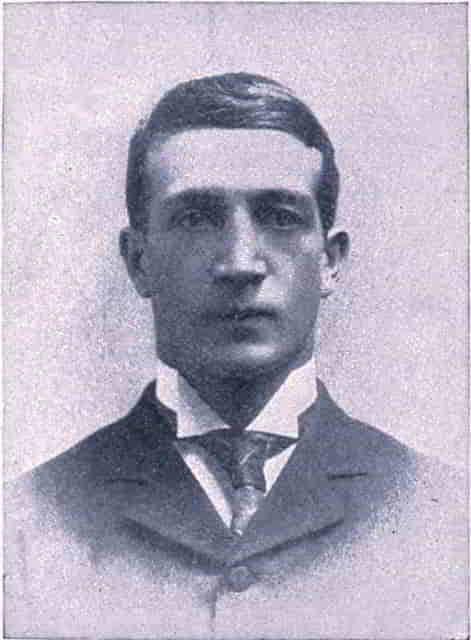 R. S. CHANNING.
R. S. CHANNING.Princeton.
When the opponents have the ball, the end rusher must, in the case of a kick, do his utmost to prevent his vis-à-vis from getting down the field early under the ball. That is the cardinal point, and it is not necessary for him to do much thinking regarding anything else when he is facing a kicking game. When his opponents are about to make a run, the situation is much more involved. He must then consider himself as the sole guardian of that space of ground extending from his tackle to the edge of the field, and he must begin at the touch line and work in. That is, he must remember that, while on one side of him there is the tackle, who will do his utmost to help him out, there is on the other side—that is, towards touch—no one to assist him, and a run around the end means a free run for many yards. "Force the man in" is always a good motto for an end, and one he will do well to follow conscientiously. To force the man in does not mean, however, to stand with one foot on the touch line, and then reach in as far as[Pg 30] possible and watch the man go by, as nine out of every ten ends have been doing for two years. It means, go at the runner with the determination of getting him any way, but taking him always from the outside. An end cannot tackle as occasionally does a half-back or back, slowly and even waiting for his man, then meeting him low and strong. An end always has to face interference, and good interference will bowl over a waiting end with ease. An end must go up as far and fast as he dares to meet the runner, and when his moment comes—which must be a selected moment—he must shoot in at his man, reaching him, if possible, with his shoulder, and at the same time extending his arms as far around him as possible. Many times this reaching enables an end to grasp his man even though a clever interferer break the force of his tackle. And[Pg 31] when his fingers touch the runner, he must grip with the tenacity of the bull-dog, and never let go.
It seems almost unnecessary to say that a high tackler has no chance whatever as an end rusher. He may play guard or centre, but before a man ever essays the end he must have passed through all the rudimentary schooling in tackling, and be such an adept that to pass him without the assistance of the most clever interference is an impossibility.
An end should be a good follower; that is, if the runner make in towards the tackle, the end should run him down from behind when interference cuts off the tackle. This is one of the best points for cultivation, because it effectually prevents any dodging by the runner. If he fail to take his opening cleanly, a following end is sure of him. This is not a safe point, however, to[Pg 32] teach until the player has fairly mastered the ordinary end-work; for the tendency is to leave his own position too soon, giving the runner an opportunity to turn out behind him, and thus elude the tackle without difficulty.
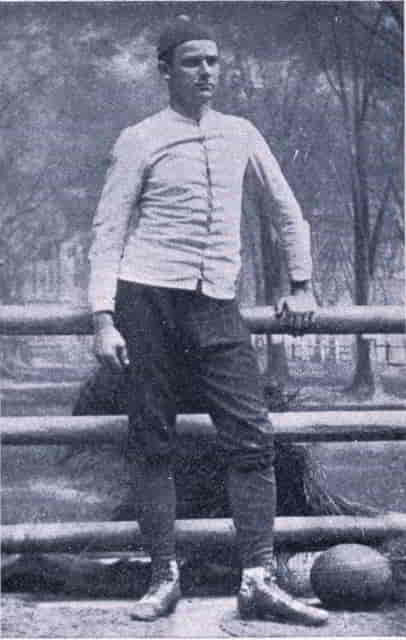 L. K. HULL.
L. K. HULL.Yale
A few years ago there was quite a fashion for the man putting the ball in from touch to run with it along the edge of the field. For some unknown reason this play seems to have been abandoned, but it is likely at any time to be revived, and the end rusher should therefore be posted upon the modus operandi of it, as well as the best method of preventing its success. The most popular execution of this man[oe]uvre was the simplest; that is, the man merely touched the ball to the ground and plunged ahead as far as he could until brought to earth or thrown out into touch. This was accompanied by more or less helpful interferences upon the part of his own end and tackle. There were more intricate methods, however; and surely, with the amount of interference allowed in these days, it is odd that the side line has not been more fancied by those who have generalled the great games. There was one team a few years ago whose captain used to deliberately place the ball just inside the line on the ground, as though only thoughtlessly leaving it there, and then spring in, crowding the end rusher three or four feet from the touch line, while a running half, who was well started, came tearing up the field, seized the ball, and usually made a long run before he was stopped by the astonished halves. Many also were the combination passes in which the ball was handed to the end rusher, who, turning suddenly with his back to the foes, would pass to his[Pg 34] quarter or running half. Of these close double passes at the edge of the field the most effective were those wherein the runner darted by just inside the touch line, and the weakest the ones wherein the attempt was made to advance out into the field. For this reason there ought to be no particular necessity for coaching any but the end rusher and the tackle upon means to prevent advances of this nature. To the players in the centre of the line there is no apparent difference whether the ball be played from touch in any of these ways above mentioned, or through the more customary channel of the quarter-back. To the end and tackle, however, the difference is marked, because the runner comes so much sooner and the play is so greatly condensed and focussed, as it were, directly upon them.[Pg 35]
The instructions to the end are to handle the ball as much as possible while the opponent is endeavoring to get it in, and thus make the work of that individual as difficult as possible; and, secondly, to plant one foot close to the touch line and the other as far out into the field as is consistent with stability, and to maintain that position until the play is over. He must neither try to go forward nor around, but, braced well forward, hold his ground. If he does this, no runner can pass within three feet of the touch line, and outside of that the tackle can take care of him. This player, like the end, should, when the ball is played from a fair, be very loath to plunge forward until the play is located, because in the present stage of development of the game one can be quite sure that the opponents will not play the ball from touch unless they[Pg 36] have some definite and usually deceptive line of action. Without such it is by far the better policy to walk out the fifteen paces and have it down. The quarter-back also has work to do upon side-line plays, in assisting at the edge as much as possible. But to return to the end. When his own side have possession of the ball, his play, like that of any other man, must be governed by the character of the intended move, and the knowledge of what this move will be is conveyed to him by the signal. The nearer the play is to his end, the greater is the assistance he can render. There is little need of coaching him to do his work when the run is along his line, nor, in fact, when it is upon his side of the centre. The knowledge of the proximity of the runner stirs him up sufficiently, if he have any football blood in him. The point towards which coaching
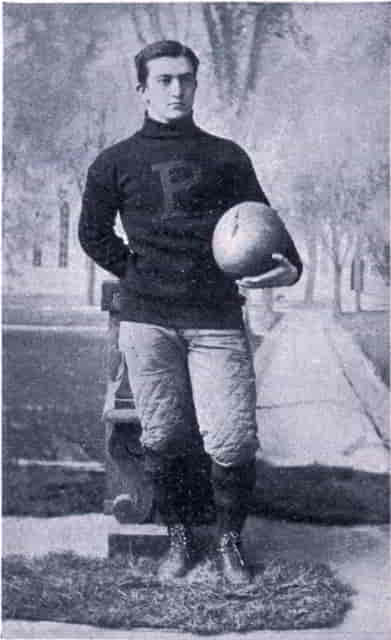 E. A. POE.
E. A. POE.Princeton.
should be directed and where it is needed is in starting instantly to render assistance when the play is upon the other side of the line. There is no limit to the amount of work an end may perform in this direction. A good end can toss his man back so that he cannot interfere with the play, and then cross over so quickly as to perform effective interference even upon end runs. In "bucking the centre" he can come from behind with valuable weight and pressure. A coach should remember, though, that it will not do to start an end into doing too much unless he is able to stand the work, for an end had better do the work well upon his own side than be only half way useful upon both ends. A tired-out end makes the opponents doubly strong.
THE TACKLE
[Pg 41]Those teams upon which the work of end and tackle has been best developed have, for the last few years, been markedly superior in the opposition offered to plays of their opponents. This fact in itself is an excellent guide to the style of play one ought to expect from these two positions. The four men occupying them are the ones to meet nine tenths of the aggressive work of the opponents. The position of end has already been dwelt upon at length. That of tackle, a position much later to reach the full stage of development than the end, has nevertheless now attained almost an equal prominence. The tackle is an assistant to both end and guard,[Pg 42] while he has also duties of his own demanding constant attention.
When the opponents have the ball and are about to kick, the tackle is one of the most active components of the line. He may not be moving until the ball is snapped, but upon the instant that it is played he is at work. He may himself go through to prevent the pass or kick, or still oftener he may make a chance for a line half-back to do this. By a line half-back is meant that one who, upon his opponents' plays, comes up into the line and performs the duties of a rusher. This method has become so common of late that it is well understood. The play of this line half-back must dovetail into the work of the tackle so well as to make their system one of thoroughly mutual understanding. For this reason they should do plenty of talking and planning[Pg 43] together off the field, and carry their plans into execution in daily practice until they become in company a veritable terror to opponents, particularly to kicking halves.
One of the very simple, yet clever and successful, combinations worked in this way has been for the line half to take his position outside the tackle, who immediately begins to edge out towards the end. This opens a gap between the opposing tackle and guard, for the tackle will naturally follow his man. This line half simply watches the centre, and as he sees the ball played goes sharply behind the tackle and through the opening. This play can be greatly aided by cleverness on the part of the tackle, who, to perform it to perfection, should edge out most cautiously, and with an evident intention of going to the outside of his man. He[Pg 44] should also watch the centre play, and, most important of all, jump directly forward into his man when the ball is snapped. This will enable the half to take almost a direct line for the half, and with his flying start have more than a fair chance of spoiling the kick. The tackle must not be idle after his plunge, but should follow in sharply, because there will always be an opposing half protecting the kicker; and if the line half be checked by this man, as is not unlikely, the following tackle has an excellent opportunity by getting in rapidly. The tackle and half should alternate in their arrangement, neither one always going through first, and thus add to the anxiety and discomfort of the opponents.
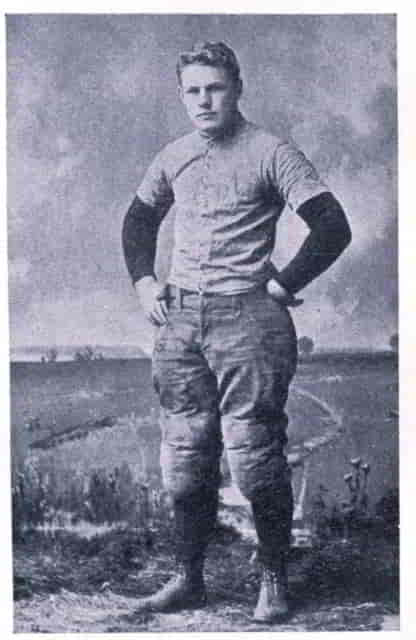 EVERETT J. LAKE.
EVERETT J. LAKE.Harvard.
When the opponents are about to run instead of kick, the same combination of line half and tackle can be put in operation, except that it will not do for these two to follow each other through with such freedom, as there is too much danger of both being shunted off by a clever turn coupled with well-timed interference. The cardinal point to be remembered is, to be far enough apart so that a single dodge and one interference cannot possibly throw off both men.
The tackle's duties towards the end have been partially described in dwelling upon the work of the latter, but there is plenty of detail to be studied. One of the first things to impress upon the tackle is, that he must watch the ball, not only upon the pass from the quarter, but also after it settles in the runner's arms, for the most successful double or combination passes are those which draw the tackle in towards the centre and give the second recipient of the ball only the end to pass. It has[Pg 46] been too common a mistake of coaches to caution a tackle who has been deceived by this double pass against "going so hard." This is wrong. It soon results in making a slow man of the player, for he hangs back to see if the runner be not about to pass the ball, until he is too late to try for the man before he reaches the rush line; and, with the present system of interference and crowding a runner after he reaches the rush line, there is no chance to stop him short of three, and it may very likely be five, yards. The proper coaching is to send him through on the jump, with his eyes open for tricks. Let him take a step or two towards the runner, so that, if no second pass be made, the tackle will be sure to meet him before he reaches the rush line, and not after it. This method of coaching makes not only sharp tackles, but quick and[Pg 47] clever ones, with plenty of independence, which will be found a most excellent quality.
As regards the relations between the tackle and guard, they are best defined by saying that the guard expects to receive the assistance of the tackle in all cases requiring agility, while in cases requiring weight the guard is equally ready to lend assistance to the tackle.
When his own side has the ball, the tackle has far more than the end to do. In fact, the tackle has the most responsible work of any man along the line, having more openings to make, and at the same time the blocking he has to perform is more difficult. The earlier description of the work of a line half and the tackle in getting through is sufficient to indicate the difficulties which the opposing tackle must face in preventing this breaking through.[Pg 48] While blocking may not be the most important duty, it is certainly the one which will bear the most cultivation in the tackles of the present day, for the ones who are really adept in it are marked exceptions to the general run. It is no exaggeration to say that more than two thirds of the breaking through that does real damage comes between the end and guard, and therefore in the space supposed to be under the care of the tackle. By successful blocking is meant, not unfair holding, which sooner or later will result in disaster, nor backing upon a runner or kicker as the charger advances, which is almost as bad as no blocking, but that clever and properly timed body-checking of the opponent which delays him just long enough to render his effort to reach his man futile every time. This kind of blocking looks so easy, and is so difficult, that it is found only in a
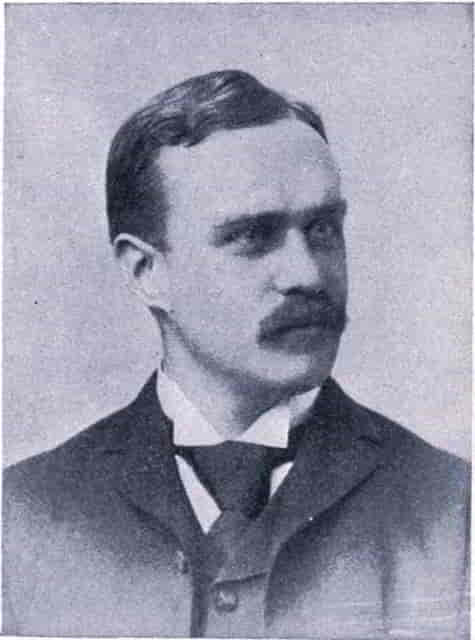 WYLLYS TERRY.
WYLLYS TERRY.Yale.
man who is willing to make a study of it. Coaching can but give any one wishing to acquire this a few points; the real accomplishment depends upon the man's unflagging perseverance and study. The first thing to be noted is, that a really good forward cannot possibly be blocked every time in the same way. He soon becomes used to the method, and is able to avoid the attempt. Dashing violently against him just as he is starting may work once or twice, and then he will make a false start to draw this charge, and easily go by the man. Standing motionless, and then turning with a sharp swing back against him, will disconcert his charge once in a while. Shouldering him in the side as he passes will throw him off his balance or against some other man, if well performed, occasionally. Falling down before him by a plunge will upset him even when[Pg 50] he has quite a clear space apparently, but it will not work if played too often. By a preconcerted plan he may be coaxed through upon a pretended snap, and then the ball played while he is guarded and five yards gained by his off-side play, but he will not be taken in again by the same method. These are but a few of the strategies which engage the study of the tackle. How soon to let the man through is also an important question. When the ball is to be punted, the tackle upon the kicker's side must block long and hard, while the tackle upon the other end should block sharply, and then let his man through for the sake of getting down the field under the kick. When a drop is to be attempted, the blocking upon both sides must be close and long, much longer than for a punt. Moreover, it is by no means a bad policy to have the[Pg 51] blocking last until the ball is actually seen in the air in front of the line, because then, if the kick be stopped, the tackles can go back to assist the backs in recovering the ball. The blocking for a kick, as a rule, should be close; that is, every opponent must be matched from the centre out, leaving the free man or men on the ends. This rule has its exceptions, but when there is any doubt about the play it is safest to block close, and take the chances from the ends rather than through breaks in the line.
In blocking for a run the case is very different, and depends upon the point of assault. If the run is to be made around the right end, for instance, by the left half-back, the right tackle must block very slowly and long. That is, he must not dash up to his man the instant the ball is snapped and butt him aside, for the runner will not be near[Pg 52] enough to derive any advantage from this, and the opponent will easily recover in time to tackle him. Rather should he avoid contact with his man until his runner makes headway, and then keep between the opponent and runner until the latter puts on steam to circle, when it is his duty to engage his man sharply, and thus let the runner pass. In blocking for an inside run upon his own side, he should turn his man out or in, as the case may be, just as the runner reaches the opening, being particularly careful not to make the break too early, lest the opponent reach the runner before he comes to the opening.
THE GUARD
[Pg 55]The position of guard, while it requires less agility than that of tackle, can never be satisfactorily filled by a man who is slow. Many a coach makes this mistake and fails to see his error until too late to correct it. I remember once seeing upon a minor team a guard who weighed at least 190 pounds replaced by a man of 155, and the latter actually filled the position—greatly to my astonishment, I confess—in excellent fashion. This does not at all go to prove that weight is of no value in a guard. On the contrary, it is a quality especially to be desired, and if one can find a heavy man who is not slow he is the choice by all means. But weight[Pg 56] must be given work to do, and that work demands practice, and slowness of execution cannot be tolerated. At the outset the coach must impress this fact upon the guards, and insist upon their doing their work quickly. It is really wonderful how much better the effect of that work will prove to be when performed with a snap and dash that are not difficult to acquire.
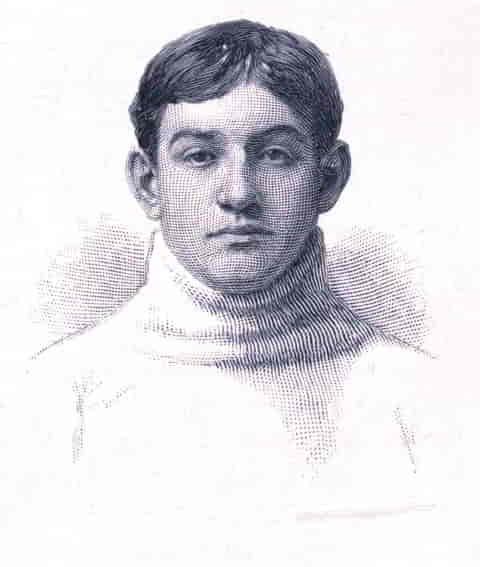 B. W. TRAFFORD.
B. W. TRAFFORD.Harvard.
When the opponents have the ball and are about to kick, the guard should have in his mind one persistent thought, and that is, to reach the quarter before the ball is away from his hand, but not to stop there. It is only once in a great while that fortune favors sufficiently to crown this attempt with success. When it does, so much the better; but the guard should take in the quarter only in a general sweep, making on for the kicker, and at the same time getting his arms up in the air when he comes before him, so as to take every possible chance of stopping the ball. Just here it may be well to explain the confidence with which in these details of coaching the phrases are used "when the opponents are about to kick" and "when the opponents are about to run." It is true that one cannot tell infallibly every time whether the play will be a kick or a run, but experienced players are really so seldom at fault in their judgment upon this point that it is safe to coach as though there never existed any doubt about the matter.
To continue with the work of the guard when the opponents are about to attempt a run. One of the most important features of the play in this position is to guard against small wedges. If a guard simply stands still and straight he will be swept over like a[Pg 58] wisp of straw by any well-executed wedge play directed at him. An experienced man knows this, and his chief thought is how to avoid it, and how, first, to prevent the formation; second, to alter the direction, and, finally, to stop the progress, of this terror of centre work, the small wedge. There are as many ways of accomplishing these results as of performing the duties of tackle or end, and it rests with the individual player to study them out. To prevent the formation of small wedges, the most successful method is that of sudden and, if possible, disconcerting movements. Jostling, so far as it is allowed, sudden change of position, a pretended charge—all these tend to break up the close formation. Once formed and started, the change of direction is usually the most disarranging play possible; but this should not be attempted[Pg 59] by the player or players opposite the point of the wedge. At that spot the proper play is to check advance, even temporarily; for the advance once checked, the wedge may be swung from the side so as to take off the pressure from behind. So it is the men at the side who must endeavor to turn the wedge and take off this pressure. Without the actual formation upon the field it is difficult to fully explain this turning of the wedge; but if the principle of the defence be borne in mind, it will not be found so hard to understand. Check the peak even for a moment, and get the weight off from behind as speedily as possible. The men who are pushing must necessarily act blindly; and if their force is not directly upon the men at the point of the V, they pass by the man with the ball and so become useless. Both guards must[Pg 60] keep their weight down low, close to the ground, so that the wedge, if directed at either, cannot throw that one at once off his balance backward. If this occurs, the wedge will always make its distance, perhaps go many yards. Lying down before the wedge is a practice based upon this principle of keeping close to the ground, and is by no means an ineffectual way of stopping an advance, although it is not as strong a play as bringing about the same result without actually losing the power to straighten up if the wedge turns. Moreover, the men in the front of a wedge are becoming so accustomed to meeting this flat defence that they not infrequently succeed in getting over the prostrate man and regaining headway upon the other side. This, as one can readily see, must always yield a very considerable gain. When a run is attempted
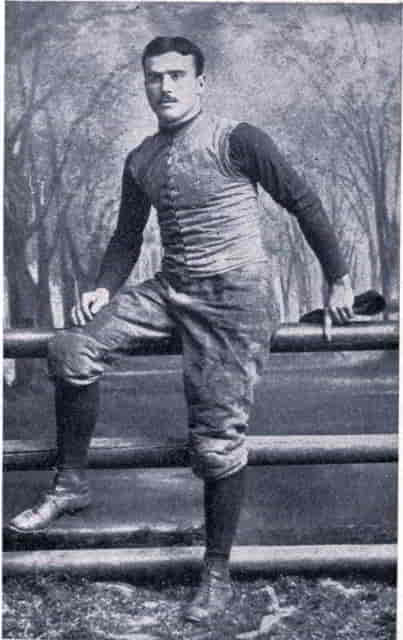 T. L. McCLUNG.
T. L. McCLUNG.Yale.
at some other point in the line, it is the duty of the guards to get through hard and follow the runner into his opening, even if they cannot reach him before he comes into the line. In this class of play a guard should remember that if he can lay a hand upon the runner before he reaches the line he can spoil the advance to a certainty, for no runner can drag a heavy guard up into and through an opening. It is like dragging a heavy and unwieldy anchor. A guard can afford to, and must sometimes, tackle high. Not that he should, in the open, ever go at the shoulders, but in close quarters he often has no time to get down low, and must make the best of taking his man anywhere that the opportunity offers. He must always, however, throw him towards the opponent's goal. Another point for guards to bear in mind is, that in close[Pg 62] quarters it is often possible to deprive the runner of the ball before he says "down." A guard who always tries this will be surprised at the number of times he will find the referee giving him the ball. He will also be astonished at the way this attempt results in the runner saying "down" as soon as he finds some one tugging at the ball. A man gives up all thought of further advance the instant he finds the ball slipping at all in his grasp; and when his attention is distracted from the idea of running, as it is when he is fearful of losing the ball, he can never make use of his opportunities to good advantage. For this reason the coach should impress upon all the forwards the necessity of always trying to take away the ball; but the men in and near the centre are likely to have the best opportunity for this play, because it is there that[Pg 63] the runner encounters a number of men at once rather than a single individual.
When his own side have the ball the guard must block sharply until the quarter has time for receiving the ball, and, at any rate, beginning the motion of the pass. It is safer, in the case of inexperienced guards, to tell them to block until the quarter has time to get rid of the ball. The distinction is this: that an experienced guard sometimes likes to gain just that second of time between the beginning of the pass and the completion of the swing, and utilize it in getting down the field or making an opening. So accustomed does he become to measuring the time correctly that he will let the opponent through just too late to reach the quarter, although it seems a very close call. It is not safe to let green guards attempt anything so close. They must be[Pg 64] taught to block securely until the ball is on its way to the runner or kicker. The blocking of a guard is much less exacting in its requirements than that of the tackle. Not that he must not block with equal certainty, but the act requires no such covering of two men as often happens in the case of a tackle. The guard forms closely towards the centre, and then follows his man out if he moves out, but only as far as he can go, and still be absolutely certain that the opponent cannot pass between him and the snap-back. To be drawn or coaxed out far enough to admit of an opponent's going through the centre shows woful ignorance in any guard.
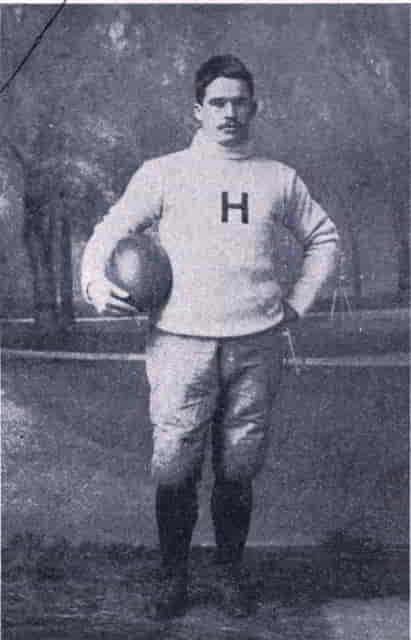 V. M. HARDING.
V. M. HARDING.Harvard.
When a kick is to be made the blocking must be prolonged a little, and on a drop-kick (as mentioned earlier) it should last until the ball goes from the foot. When blocking for a run, of course much depends upon where the opening is to be made, and a guard must be governed accordingly. The method itself is, again, different in the guard from that exhibited in the tackle. A guard may not move about so freely and must face his man more squarely than a tackle, for the guard must protect the quarter first, while the tackle considers the half only. If a guard allows his opponent to get a fair lunge with outstretched arm over or past his shoulder, he may reach the quarter's arm even though his body is checked, while such a reach at the point in the line occupied by the tackle would be of no value whatever. Previous to the snap-back's playing the ball it is the duty of the guards to see that their individual opponents do not succeed in either kicking the ball out from the snap-back's hand or otherwise interfering[Pg 66] with his play. This is quite an important feature, and a centre should always feel that he has upon either hand a steady and wide-awake assistant, who will neither be caught napping nor allow any unfair advantage to be taken of him. The guard should bear in mind one fact, however, and that most clearly. It is that squabbling and general pushing about are far more liable to disconcert his own centre and quarter than to interfere with the work of the opponents.
THE CENTRE, OR SNAP-BACK
[Pg 69]The man who may be selected to fill the important position of centre-rush must be a man of sense and strength. Brain and brawn are here at their highest premium. But there is another element of character without which both will be overthrown, and that is patience. Practical experience has taught football coaches that none but a thoroughly self-controlled man can make a success in football in any position, while in this particular one his disposition should be of the most equable nature. He will be called upon to face all kinds of petty annoyances, for his opponents will endeavor to make his play as difficult as possible; and never must he allow[Pg 70] himself for one instant to lose sight of the fact that his entire attention must be devoted to his play, and none of it distracted by personal feeling. Moreover, while he must be able to play the ball quickly when called upon, he can never afford to be hurried by his opponents. With the present excellent rulings of umpires regarding interference with the ball before it is snapped, much of the most harassing kicking of the ball from under his hand has been stopped; but, for all that, he is indeed a lucky centre who does not feel the ball knocked out from under his grasp several times during a game. In addition to this, every man who breaks through gives him a rub. Sometimes these knocks are intentional, often they are given purely by accident, and the latter are by no means the lightest. Then, too, a man is pushed into the snap-back[Pg 71] just as the ball goes. It may be his own guard, but the blow hurts just as much; and a centre who is not amiable under such treatment soon loses his head and forgets that he should care for nothing except to accomplish gains for his own side. The object of placing so much stress upon this qualification is to impress upon a coach the almost inestimable value of the quality of patience in any men he may be trying for this position. He can never say too much about it.
As regards the duties of the place, they differ from those of any other position in the line on account of the constant presence at that spot of the ball. The centre is either playing the ball himself or watching his antagonist play the ball at every down; so that while he has all the other duties of a forward to execute, he has the special work besides.[Pg 72] Here is the weakness of so many centres. They are snap-backs only or forwards only, the former being by all odds the more common. A good critical coach of experience will see nine out of every ten men whom he may watch in this position playing through day after day with no more idea of doing any forward work than if they were referees. Putting the ball in play at the right time, and properly, is a great achievement, but it does not free the centre-rush from all other obligations. He must protect his quarter; he must aid in making openings, and perform any interference that may be possible, as well as always assisting a runner of his own side with weight or protection. He must always get down the field under a kick, for it is by no means unusual for him to have the best opportunity in these days when end rushers are so carefully watched. When the opponents have the ball, he must not be content with seeing that the opponent does not roll it to a guard, but must also see that there is no short, tricky passing in the scrimmage. Then he must be as ready as either guard to meet, stop, or turn a wedge. He must make openings for his comrades to get through, even when he himself may be blocked, and always be ready to reach out or throw himself before a coming runner to check the advance.
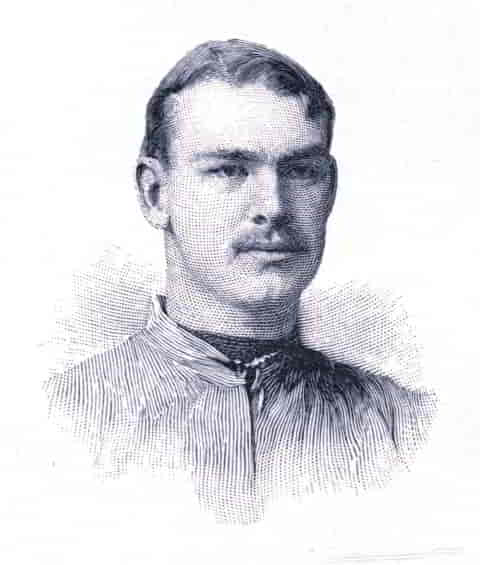 JESSE RIGGS.
JESSE RIGGS.Princeton.
The details of the special work of the centre are many, and thorough knowledge of them can only come from experience. During his early progress a new snap-back usually sends the ball against his own legs, or, if he manages to keep them out of the way, is upset by his opponent for his pains. It is no child's play to hold a ball out at arm's-length[Pg 74] on the ground in front of one and roll it back so that it passes between one's feet, and still preserve a good balance in spite of a sudden push of a hundred-and-eighty-pound opponent. But that is just what a centre has to do every time the ball is down and belongs to his side. The first thing to teach a centre is to stand on his feet against any amount of jostling. Then he must learn to keep possession of the ball until ready to play it. Both of these acquirements take practice. The most finished and experienced centres have a way of playing the ball just as they are half straightening as though to meet a charge from in front. This insures their not being pushed over on to the quarter, and yet does not cause them to lean so far forward as to be pitched on their noses by a little assistance from the opposing centre. When[Pg 75] a man stands so as to prevent a push in the chest from upsetting him, he naturally puts one foot back some distance as a support. When a centre does this he is apt to put that foot and leg in the path of the ball. A second objection to this way of standing is, that the centre does not offer nearly as much opposition to any one attempting to pass as he does when he stands more squarely faced about with a good spread of the legs. As to holding the ball, some centres prefer to take it by the end, while others roll it on its side. It can be made to rise for the quarter if sent on end, whereas if played upon its side it lies closer to the ground. The quarter's preference has, therefore, something to do with it. It requires longer practice and more skill to play the ball on its end, but it permits an umpire to see more clearly whether the ball be[Pg 76] actually put in play by the snap-back or played for him by the surreptitious kick of the opponent. It has also the advantage of sending the ball more narrowly upon a line, so that its course is less likely to be altered than when rolled upon its side. While the snap-back is seldom held to the very strictest conformity to the rule about being on side when he puts the ball in play, it is necessary for him to practise with a view to this particular, because he is liable to be obliged to conform every time if the opponents insist. The reason for carelessness in this respect is, there is no penalty for infringement except being obliged to return to the spot and put the ball in play properly. A certain laxity, therefore, is granted rather than to cause delays. But, as stated above, a centre must be able to put the ball in play when fairly on side, and must live
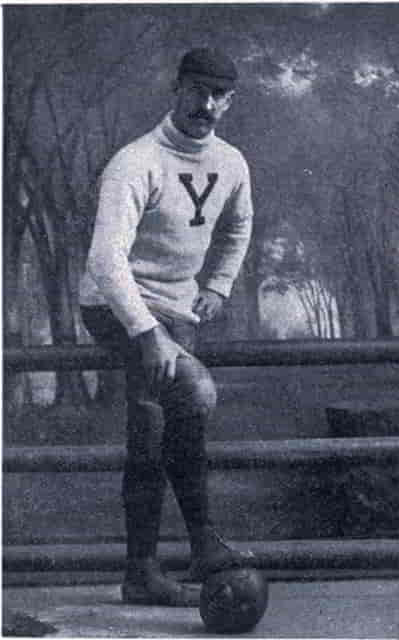 W. H. CORBIN.
W. H. CORBIN.Yale.
up to this with some moderate degree of regularity, or else the umpire will call an off-side and bring him back. A centre ought to practise putting the ball in play with either hand until he is fairly proficient with his left as well as his right. Not that he should use his hands alternately in a game, but that an injury to his right hand need not necessarily throw him out of the game. It is by no means an unrecognized fact that the greater amount of experience possessed by the regular centre is so valuable as to make it policy to keep him in his place so long as his legs are good, even though a hand be injured, rather than to replace him by the substitute with whose methods the quarter-back is not so familiar.
A coach should see to it that his centre has a variety of men to face, some big, some tricky, some ugly. If any old players[Pg 78] come back to help the team in the way of coaching, and among them are some centre rushers, they can do no better work than by donning a uniform and playing against the "'Varsity" centre.
THE QUARTER-BACK
[Pg 81]The quarter is, under the captain, the director of the game. With the exception of one or two uncommon and rare plays, there is not one of any kind, his side having the ball, in which it does not pass through his hands. The importance of his work it is therefore impossible to overrate. He must be, above all the qualifications of brains and agility usually attributed to that position, of a hopeful or sanguine disposition. He must have confidence in his centre himself, and, most of all, in the man to whom he passes the ball. He should always believe that the play will be a success. The coach can choose no more helpful course during the first few days,[Pg 82] as far as the quarter is concerned, than that of persuading him to repose confidence in his men. Many promising half-backs are ruined by the quarter. There is nothing that makes halves fumble so badly, get into such awkward positions, start so slowly, and withal play so half-heartedly, as the feeling that the quarter does not think much of them, does not trust them, or believe in their abilities. Every half-back can tell the same story—how he is nerved up by the confidence of the quarter, and what an inspiration it is to good work to see that confident look in the eye of the man who is about to pass to him. But not alone in the work of the half does it make a great difference, but in that of the quarter himself. When he lacks confidence in his man, his passing is unsteady and erratic as well as slow. He allows the opponents a far better chance of reaching[Pg 83] the man before he can get started, both by irregular and slow passing, and also by a nervous looking at him before the ball is played.
In practice, great stress should be laid on quick handling and sharp passing of the ball. A quarter can slow up in a game if advisable, but he can never do any faster work than that which he does in practice without throwing his men completely out. In order to make the play rapid, a quarter must be figuratively tied to the centre's coat, or rather jacket, tails. As soon as the centre reaches the ball after a down, he should know that the quarter is with him. Usually there is an understood signal between them, which not only shows the centre that the quarter is on hand, but also when he is ready to receive the ball. One of the most common of these signals has been placing the hand upon the centre's leg[Pg 84] or back. A pinch would let him know when to snap the ball. In spite of this method's having been used by opponents to fool a centre, it has been, and still is, the most common. One of the best variations of it has been for the quarter to put his hand upon the centre and keep it there until he is ready for the ball, then take it off and let the centre snap the ball, not instantly, but at his convenience. Should anything occur making it advisable, for some reason, to stop the play, the quarter puts his hand upon the centre again at once, and until it is once more removed the snap-back understands that the quarter is not ready to have the ball come. Almost any amount of variation can be made in the signal of the quarter to his centre; but in arranging this it should be constantly borne in mind that the signal should not be such as to give the opponents the exact instant of the play, because it gives them too close an idea of the moment when they may start.
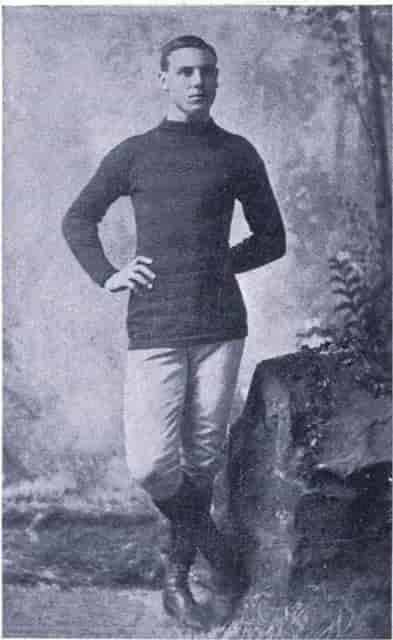 ALEXANDER MOFFATT.
ALEXANDER MOFFATT.Princeton.
The speed of a quarter's work depends upon his ability to take the ball close to the snap-back and in proper position for a pass. In merely handing the ball to a runner, one might suppose that there would be no particular position in which the ball should be held; but in that he would be in error, for a ball so handed to a passing runner as not to settle properly in his arms or hands means in many instances a disastrous fumble, or at best a slowing-up of the runner's speed. In giving the ball to a passing runner, it should be held free and clear of the quarter's body and slightly tilted, so that it can be taken against the body, and without the use of both hands for more than an instant, because the runner must almost immediately[Pg 86] have use for his arm in going into the line. It is impossible to give in print the exact angle and method of holding the ball for this purpose, but practice and the wishes of the runners, if consulted, will soon show the quarter just what is meant. When the ball is to be passed any considerable distance, it should be taken so that the end is well placed against the hand of the quarter, while the ball itself lies against the forearm, the wrist being bent sharply. This will enable the quarter to send the ball swiftly and accurately almost any distance that it may be necessary to cover. Of course, in many cases the ball does not actually rest against the forearm of the quarter; but this is the best way of conveying the idea of the proper position of the hand upon the point of the ball, and by practising in this way the correct motion for steady[Pg 87] passing is speedily acquired. In receiving the ball, the right hand, or the hand with which the throw is made, should be placed upon the end of the ball, while the other hand stops its progress, and should be placed as nearly upon the opposite end of the ball as convenient. This is the theoretically proper way of receiving the ball; practically, the handling cannot be as accurately performed as this would indicate. If, however, the quarter will in practice be constantly aiming at receiving the ball so that his right hand grasps the end just as his left hand stops the ball, and settles it securely against his right, he will find that after a few weeks he can receive four out of five snap-backs in such a way as to make any great amount of arranging the ball for his pass, after it is in his hands, quite unnecessary. After the preliminary weeks of practice, and when[Pg 88] in a game, he must bear in mind the fact that, in order of importance, his duties are, first, to secure the ball, no matter how; second, to convey it to his own man, no matter whether in good form or not. He must never pass the ball if he has fumbled it, unless he has a perfectly clear field in which to do it. He must always have it down in preference to taking the slightest risk of losing it. Even though he receive it without a fumble, there may be a way through in that part of the line towards which his pass is to be delivered; and here, again, he should hold the ball for another down rather than take any chance of the opponent's intercepting the pass. After letting the ball go, the quarter should follow his pass; in fact, he should be almost on the run as the ball leaves his hand. No matter whether the ball be caught or fumbled, he is then
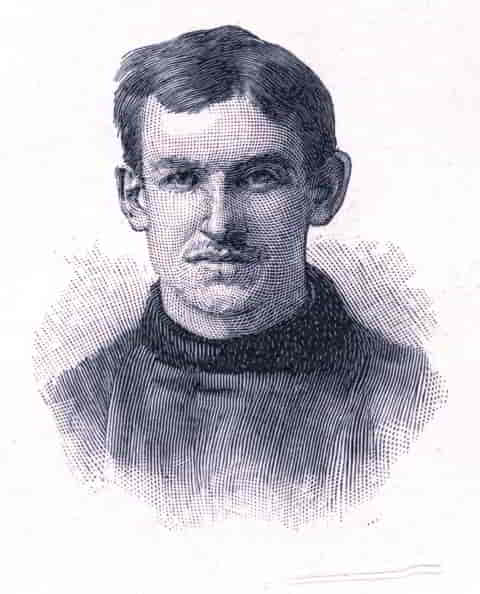 RALPH WARREN.
RALPH WARREN.Princeton.
ready to lend assistance; whereas if he stand still after his pass, he is of no use to the rest of the play. When the play is a run, he can do excellent work in interfering; and when the play is a kick, he can take any opponent who gets through, and thus aid the half in protecting the kicker. In either case, if his own man muff or fumble he is close at hand to lend assistance in an emergency, which otherwise might prove most disastrous. When lining up the quarter should take a quick glance, not directly at the player he is to make the recipient of the ball, but covering the general position of all the men. In doing this he locates his individual without making it apparent to the opponents which man is to receive the ball. Any amount of disguise may be practised in the way of taking a last glance at the wrong man, or calling out to some one who does not[Pg 90] enter into the play. The chief point, nevertheless, is to avoid that tell-tale glance at the right man which is so difficult to omit.
When the opponents have the ball, the quarter makes an extra man in or near the forward line, and, as a rule, he can by his shrewdness make it very uncomfortable for any point in the line which he chooses to assail. No law can govern his tactics in this respect, but he should be a law unto himself, and show by his cleverness that he is more valuable than any man in the line whose position is fixed. One caution only is worth giving to the quarter in this line of play, and that is, to be less free of going forward sharply when the play is evidently to be a run than when a kick is to be attempted. In the latter case, a quarter can always be sent for his best.
THE HALF-BACK AND BACK
[Pg 93]As the game is at present played, the back is more of a third half-back than a goal-tend, and so should be trained to half-back work. It has been well said that all that one can ask of the best rush line is to hold the ground their half-backs gain; and when one follows carefully the progress of the play, he sees that this is the proper division of the work. The half-backs, then, must be the ground-gainers of the team. Such work calls for dash and fire—that ability to suddenly concentrate all the bodily energy into an effort that must make way through anything. Every one has such half-backs in mind, but unfortunately many of those half-backs who[Pg 94] possess this type of character have not the necessary weight and strength to stand the amount of work required. Although a light man be occasionally found who is particularly muscular and wiry, the constant shock of going into a heavy line of forwards usually proves too exhausting for any but those of middle weight before the end of a season be reached. It is not that the work of a single game proves too much for the light-weight half. It is that in both practice and games he is so overmatched by the weight of the forwards whom he must meet that every week finds him less strong than the preceding, until his playing falls off so markedly that the captain or coach is at last convinced that there is something wrong, and the man is replaced by some one else, often too late to bring the substitute up to anything like the mark he might have[Pg 95] reached had he been tried earlier in the season. Such thoughts as these will suggest themselves to the experienced coach when at the outset of a season he has placed before him a number of candidates for the position of half-back, among whom very likely there may be two or three men of perhaps one hundred and forty pounds' weight. Likely enough, too, these men may be at that period easily superior to the middle or heavy weights. In such a case the very best advice that can be whispered in the ear of coach or captain is, to make quarters or ends of them, even though it be only substitute quarters and ends. It will leave the way open for the proper cultivation of half-backs better built to stand the wear and tear of a season.
Almost equally to be deprecated is the waste of time often devoted to making half-backs of slow heavy weights. Only[Pg 96] a quick man can perform a half-back's duties successfully; and although much can be left to practice, there must be some natural quickness to build upon. Slow men can be improved far more rapidly in the forward line than among the halves. All this regarding the weight of half-backs applies not only to 'varsity teams, but school teams as well, if one will make the proper proportional changes in weight. That is, a 'varsity player will be called upon to face a forward line averaging one hundred and seventy-five or thereabouts, and men of less than one hundred and thirty-five to one hundred and forty are too light to meet that weight. In school teams the rush line will be some twenty pounds lighter, and the halves can therefore be selected from even one-hundred-and-twenty-five-pound men, if well built. In other words, a half-back ought not to
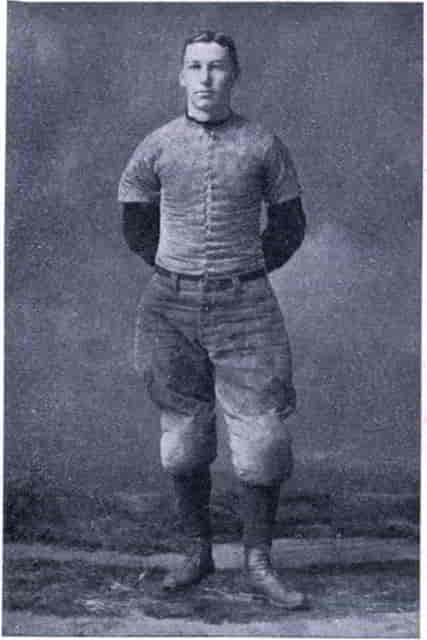 JOHN CORBETT.
JOHN CORBETT.Harvard.
face over twenty-five pounds' difference in weight; and the more that difference is reduced, supposing that speed and agility be retained, the more chance there is of turning out a thoroughly successful player. It is worth while to be thus particular upon the point of the early selection of candidates for the position of half-back, because, while no more work is demanded of them in a game than of others of their side, the quality of that work must be more uniformly good. When a half-back has to tackle, he must be as sure as a steel-trap; when a half-back has to catch, he must be a man to be relied upon; when a half-back is called upon for a kick, it must be no fluke; and, although no one expects a half-back to always make on his run the five yards, he must be a man who will not be denied when he is called upon for that last yard[Pg 98] which will enable his side to retain the ball.
Almost the first thing to be critically noted by the coach is the way in which a half-back takes the ball from his quarter. The case in which he takes it directly from the hands of this player has been already dwelt upon at some length under the head of the quarter's passing; but when the ball is thrown or passed some little distance, it is just as important that it be properly received. Except when about to kick, the half-back should be moving when he receives the ball, and, more than that, the reception of it should have no perceptible effect upon his movements. In other words, he must take it as easily and as naturally as a batsman in a ball game drops his bat after he has hit the ball fairly. No batsman remembers that he has had the bat in his hands after the ball[Pg 99] has been hit, and yet, when he is at first base, he has left his bat behind him at the plate. Thus a football half-back should so receive the ball as not to know the exact instant of taking it, but find that he has it as he comes up to the line. It will never do for a coach to suppose that an inexperienced half can be told that he must take the ball "without knowing it," but it is necessary to explain to a half that until he does take the ball naturally, and without having to stop and calculate about it, he can never come properly up to the line nor get his whole power on early. To acquire the habit of taking a pass easily, a half-back should spend a little time every day off the field in practising taking a sharp pass when on the run. By a sharp pass is not meant hurling the ball with all possible force against a runner so that he is nearly[Pg 100] knocked over by it, and cannot by any possibility catch it except at the expense of giving the catch his sole and undivided attention. Such passing in practice does far more harm than good. The ball should be passed with that easy swing which sends it rapidly, accurately, and evenly up to the runner without any great apparent force, for it is remarkable how much the appearance of force tends to rattle the runner, who easily handles fully as much speed properly delivered. Daily practice of this nature between the quarter and halves accustoms each to the other, so that the regular work of the team on the field is not disorganized by loose passing and looser catching. While this passing is progressing, the coach should stand by the side of the half, and watch him closely, correcting any careless tendencies of receiving or stopping, and paying
 W. BULL.
W. BULL.Yale.
particular attention to his going in a straight line—that is, not running up to meet the ball and then sheering off again. The best half-backs endeavor to receive the ball at approximately the same height relative to their bodies, no matter how it comes, and they will correct quite a variation in the quarter's throw by a little stoop or a slight jump. A half-back must be taught to be uniform in starting, and in reaching the spot where the ball is to meet him. The coach will have no great difficulty in teaching him this steady uniformity of pace, which will enable the quarter to throw the ball so as really to assist rather than retard his motion. There are two other things which the half-back must practise apart from his team-play. They are kicking and catching. The former is of sufficient importance to deserve a separate chapter, but a few hints[Pg 102] under the half-back column will not be out of place. It is usually the case that of all three men behind the line, the two halves and the back, any one can do the kicking upon a pinch, but one of the three is, nine times out of ten, manifestly superior to the other two. In this state of affairs there is altogether too great a tendency to slight the practice of the two inferior kickers, and rely almost entirely upon the best man. It is quite proper to let the best man do all the kicking possible in an important game, but it is a very short-sighted policy to neglect the practice of the other two during the preliminary games. Not only should they have the advantage to be gained in the length of their kicks by daily practice, but they should also have the steadying experience to be acquired only in games. It may happen at any moment in a most important game that[Pg 103] the kicking will devolve upon them on account of an accident to the third man, and it is, indeed, a foolhardy captain or coach who has not taken sufficient forethought for this contingency. The principal reason why we develop so few really good kickers is, that coaches, captains, and players have given so little attention to the detail of that part of the work. Fully nine tenths of the men who do the kicking upon American teams are more natural kickers than practised ones. Let me explain this so as to be fully understood. As in boxing one often sees a man who, having taken no lessons, and being therefore unable to make the most of himself, can yet more than hold his own against a more finished opponent on account of his natural quickness, strength, and aptitude; so in football one sees here and there a man who is able to do some fair[Pg 104] kicking without having devoted particular attention to it. In boxing, however, when a teacher takes the natural hitter in hand, he begins by putting him at work upon the rudiments of guarding, holding himself upon his feet, hitting straight, and moving firmly. He never undertakes to make a first-class man of him by merely encouraging him to go in harder, and increase his power without regard to the proper methods. In football, coaches rarely teach the kickers the first principles, but instead urge upon them only the necessity of constant practice in their own way. For this reason our kickers show all manner of styles, and the only wonder is that they kick so well in such wretchedly bad form.
While it is neither advisable nor necessary that a kicker be prevented from attempting to kick hard until he has mastered every detail of the swing and brought it to the same point of perfection that a finished oarsman does his stroke, it certainly is best, in his practice, to subordinate power to method until he acquire good form.
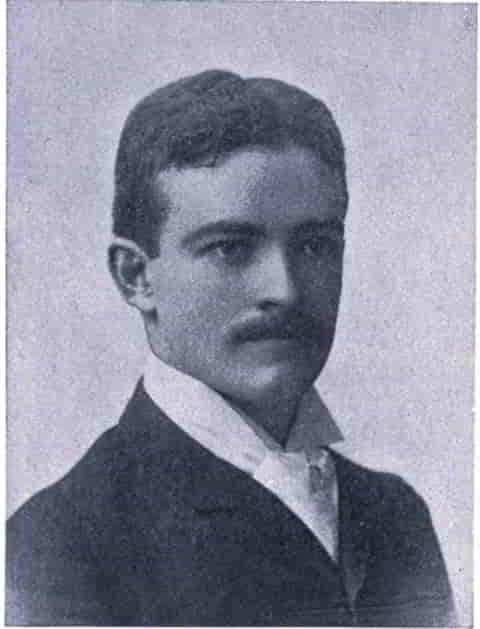 KNOWLTON L. AMES.
KNOWLTON L. AMES.Princeton.
The coach should take his man in hand by watching him make a half-dozen kicks in his own way. Then he should select the worst of his faults, and show him why it is a fault, and how to correct it. He should keep him upon this one point for a few days, until he is convinced that there will be no backsliding, and then begin upon the next. In this way a few weeks will serve to make a second-class man a good one, and open the way for his becoming something out of the ordinary run in another season.
In judging the faults of a kicker, the coach should note just where he gets[Pg 106] his power on, what is the position of his leg and foot upon the swing, and what part of the foot strikes the ball. These are the principal points, and deserve the first attention. Regarding the first of these, his power should be put on just as his foot has passed the lowest part of the arc in which it swings, and it should meet the ball in the upward sweep very soon after passing this point. The position of his leg and foot is to be next noted, and the "snap the whip" phrase is as good a one to convey the idea as any that can be adopted. As the leg begins to swing the knee is bent and the body pitched a little forward, so that the weight of the kick seems to start from the hip and travel down the leg as it straightens, reaching the foot just as it meets the ball, as above mentioned. As for the third point, the ball, when punted,[Pg 107] should be struck between the instep and the toe, impinging most upon the former. In a drop-kick and a place-kick the ball is met by the toe, and the sweep is made with "a longer leg," as the expression has it; that is, the foot swings nearer—in fact, almost along the ground.
All these three points can be most clearly illustrated by noting the effect of departures from them. If the power is not put on as above described, the man will simply send the ball along the ground, or will hook it up, merely tossing it with his foot instead of driving it. These two are the extremes, of course; but they illustrate where the power is lost or wasted. If the leg be not swung in proper position, the ball will be simply spatted with the foot, the only force coming from the knee. Finally, if the ball be not met with the proper part of the foot it may snap downwards off the[Pg 108] toe, or be merely bunted by the ankle. There is still another thing to be watched, which, while not the kick proper, really belongs to it as much as the swing of the leg. It is the way in which the ball is dropped to the foot from the hand or hands. The usual tendency of beginners, and many half-backs who could hardly be classed in that category, is to toss the ball from the hand; that is, to give it a motion up from the hand, which, however slight, causes much valuable time to be lost. The ball should always be dropped to the foot, the distance between the hand and foot being made as short as possible. The hand should be merely withdrawn just at the proper moment, and with practice it is not difficult to make the entire transfer from hand to foot so rapid as to almost eliminate any danger of having the ball stopped or struck during that part of the play. In drop-kicking[Pg 109] the fall is necessarily greater, but it should never be a toss even then. There has been no little argument as to whether the ball should be held in one or both hands when about to kick, and such are the examples of good kickers arrayed on both sides that one cannot fairly say that either way is the only right way. If a player has become so accustomed to the two-hand method as to make him uncomfortable and inaccurate if forced to the one-hand way, it is hardly advisable to make the change. But any player who is taken early enough can be taught to drop the ball with one hand, to the great advantage of both his quickness and his ability to kick from tight quarters or around an opponent.
The entire series of motions, therefore, which go to make up a well-performed kick should be in the coach's mind just as the separate parts of an[Pg 110] oarsman's stroke are in the boating-man's mind when coaching a crew. The ball dropped, not tossed; the leg well swung, the power coming from both leg and hip with all the advantage that the poise of the body may add; the foot meeting the ball with the forward part of the instep on a punt, with the toe on a drop, and in either case just after passing the lowest point of the arc of swing, rather later on a punt than a drop, because the ground helps the latter to rise, while the rise of the former must come entirely from the foot. The next step in the education of the kicker is the side swing. The ball cannot be kicked as far when met directly in front of the kicker—his leg swinging straight, as it would in taking a step in running—as it can be kicked by taking a side sweep with the leg and body, the hips acting as a sort of pivot.[Pg 111]
One of the most common false ideas regarding this side kick is, that it is not performed with the same part of the foot as the straight punt, but that the ball is struck by the side of the foot. Of course, this is all wrong. The foot meets the ball as fairly and directly as it does in the ordinary straight kick, and the ball impinges upon the top of the instep and toe just as before, the word "side" referring to the swing of the leg and position of the body only.
All the suggestions thus far have been applicable to both half-backs and back, but before bringing the chapter to an end it is well to note a few of the special features of the full-back's position. The place originally was that of a goal-tend, but with the increase of the aggressive system of defence his duties have become more those of a third half-back. Other things being equal, it is[Pg 112] eminently proper to select as a full-back an exceptionally strong tackler; but as for placing tackling ability above that of kicking, that is a mistake which might have been made six years ago, but of which no coach or captain would to-day be guilty.
The importance of the position is rapidly growing, and there is no doubt that the time will come in another year, if it be not already here, when the selection of the three men behind the line will be after this fashion—namely, picking out the three best half-backs, all things considered, then selecting that one of the three whose kicking is the best, and making him the third half or full back. After the man has been in this way chosen there will devolve upon him certain duties which do not commonly fall to the lot of the other two half-backs. Chiefest among these is the
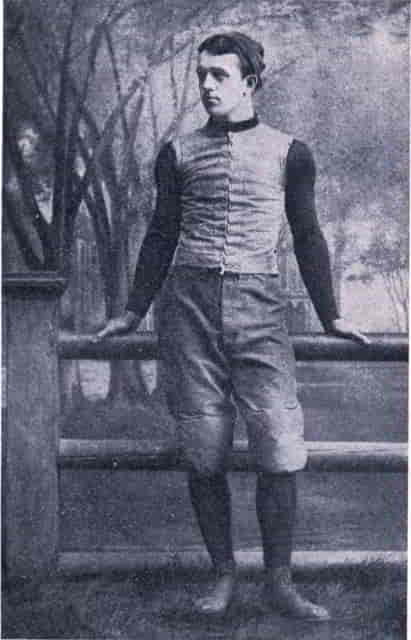 W. C. RHODES.
W. C. RHODES.Yale.
duty of making a running return of a kick. The opponents have sent a punt down towards him, which he secures while the opponents are still some yards away from him, although they are coming down rapidly. In this case, a thoroughly finished player will not only gain a few steps before he takes his kick, but he will take that kick on the run, sometimes dodging the first man before taking the kick. A full-back who can do this and never lose his kick is the greatest kind of a treasure for any team, and it is worth a captain's while to devote a good bit of attention to the full-back's perfecting this special feature of his play.
He will also be likely to have the long place-kicking to do. In fact, it is proper to practise him at this, because, if he be the best punter among the men behind the line, he can be made the longest place-kicker, and few realize the great[Pg 114] advantage of these long place-kicks to a team upon occasion of fair catches.
Tackling, when it does fall to the lot of a full-back, comes with an importance the like of which no other player is ever called upon to face. It usually means a touch-down if he misses. For practice of this kind it is well to play the 'varsity back once in a while upon the scrub side. This is likely to improve the speed of his kicking also.
SIGNALS
[Pg 117]When Rugby football was first adopted in this country, it was against a strong feeling that it would never make progress against what had been known as the American game. This old-fashioned game was much more like the British Association in a rather demoralized state. Not only was there no such thing as off-side, but one of the chief features consisted in batting the ball with the fist, at which many became sufficiently expert to drive the ball almost as far as the ordinary punter now kicks it. There was very little division of players by name, although they strung out along the field, and one (known as the "peanutter"—why, no one knows) played in[Pg 118] the enemies' goal. Coming to players accustomed to this heterogeneous mingling, it is no great wonder that the first days of Rugby were characterized by even less system than that displayed in the old game.
The first division of players was into rushers, half-backs, and a goal-tend. The rushers had but little regard for their relative positions in the line; and as for their duties, one can easily imagine how little they corresponded with those of the rusher of to-day when it is said that it was by no means unusual for one of them to pick up the ball and punt it.
The snap-back and quarter-back play soon defined these two positions, and shortly after the individual rush line positions became distinct, both as regards location and duties. All this was an era of development of general play with but few particular combinations or marks of[Pg 119] strategy. If a man made a run, he made it for the most part wherever he saw the best chance after receiving the ball, and he made it unaided to any degree by his comrades. If the ball was kicked, it was at the option of the man receiving it, and the forwards did not know whether he would kick or run.
It was at this point that the demand for signals first showed itself. The rushers began to insist upon it that they must be told in some way whether the play was to be a kick or a run. They maintained quite stoutly and correctly that there was no reason in their chasing down the field when the half-backs did not kick. As a matter of fact, the forwards even went so far as to contend that the running-game should be entirely dropped in favor of one based upon long kicks well followed up. Failing to establish this opinion, they nevertheless[Pg 120] brought it about that they should be told by some signal what the play was to be, and so be spared useless running. This was probably the first of the present complicated system of signals, although at about the same time some teams took up the play of making a rather unsatisfactory opening for a runner in the line, and made use of a signal to indicate the occasions when this was to be done. The signalling of the quarter to the centre-rush as to when the ball should be played antedated this somewhat, but can hardly be classed with signals for the direction of the play itself.
To-day the teams which meet to decide the championship are brought up to the execution of at least twenty-five different plays, each of which is called for by a certain distinct signal of its own.
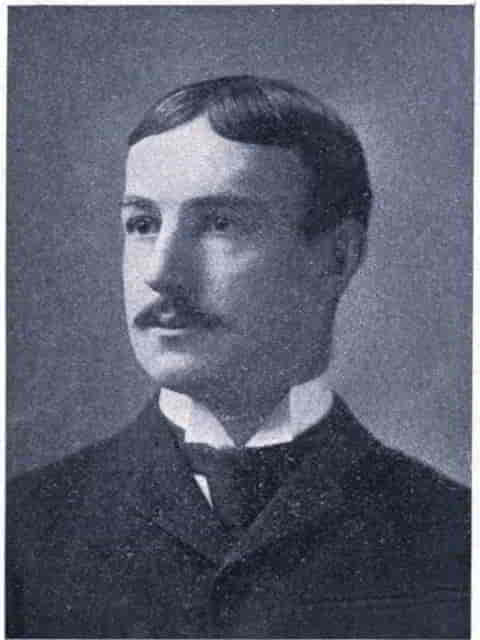 P. D. TRAFFORD.
P. D. TRAFFORD.Harvard.
The first signals given were "word signals;" that is, a word or a sentence called out so that the entire team might hear it and understand whether a kick or a run was to be made. Then, when signals became more general, "sign-signals" (that is, some motion of the hand or arm to indicate the play) were brought in and became for a time more popular than the word signals, particularly upon fields where the audience pressed close upon the lines, and their enthusiastic cheering at times interfered with hearing word signals. Of late years numerical combinations have become most popular, and as the crowd is kept at such a distance from the side lines as to make it possible for teams to hear those signals, they have proven highly satisfactory. The numerical system, while it can be readily understood by the side giving the signal, because they know the key, is far more difficult for the[Pg 122] opponents to solve than either the old word signals or signs. Still, the ingenuity of captains is generally taxed to devise systems that shall so operate as never to confuse their own men and yet completely mystify the opponents throughout the game. Clever forwards almost always succeed in interpreting correctly one or two of the signals most frequently used, in spite of the difficulty apparent in the solution of such problems. The question as to who should give the signals is still a disputed one, although the general opinion is that the quarter-back should perform this duty. There is no question as to the propriety of the signals emanating from that point, but the discussion is as to whether the captain or the quarter should direct the play. Of course all is settled if the captain is himself a quarter-back, but even when he is not he ought[Pg 123] to be able to so direct his quarter previous to the actual conflict as to make it perfectly satisfactory to have the signals come from the same place as the ball. It is in that direction that the eyes and attention of every player are more or less turned, and hence signals there given are far more certain to be observed. Moreover, it is sometimes, and by no means infrequently, necessary to change a play even after the signal has been given. This, if the quarter be giving the signals, is not at all difficult, but is decidedly confusing when coming from some other point in the line.
The important fact to be remembered in selecting a system of signals is that it is far more demoralizing to confuse your own team than to mystify your opponents. A captain must therefore choose such a set of signals as he can be sure of making his own team comprehend[Pg 124] without difficulty and without mistake. When he is sure of that, he can think how far it is possible for him to disguise these from his opponents. Among the teams which contest for championship honors it is unusual to find any which are not prepared for emergencies by the possession either of two sets of signals, or of such changes in the manner of giving them as to make it amount to the same thing. Considering the way the game is played at the present time, this preparation is advisable, for one can hardly overestimate the demoralizing effect it would have upon any team to find their opponents in possession of a complete understanding of the signals which were directing the play against them.
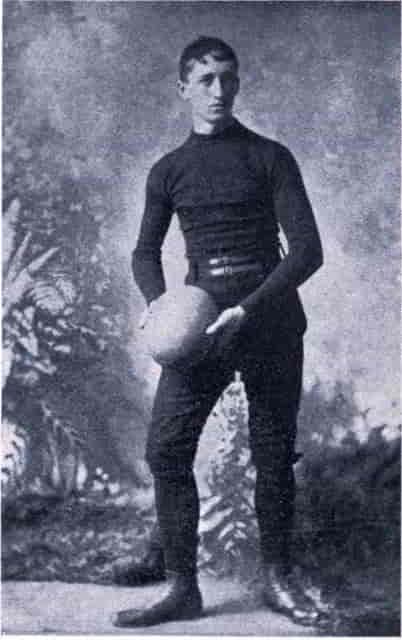 R. HODGE.
R. HODGE.Princeton.
While it is well for the captain or coach to arrange in his own mind early in the season such a basis for a code of signals as to render it adaptable to almost indefinite increase in the number of plays, it is by no means necessary to have the team at the outset understand this basis. In fact, it is just as well to start them off very modestly upon two or three signals which they should learn, and of which they should make use until the captain sees fit to advance them a peg.
If, for instance, the captain decides to make use of a numerical system, he cannot do better to accustom his men to listening and following instructions than to give them three signals, something like this: One-two-three, to indicate that the ball is to be passed to the right half-back, who will endeavor to run around the left end; four-five-six, that the left half will try to run around the right end; and seven-eight-nine, that the back will kick. The scrub side[Pg 126] will probably "get on" to these signals in short order, and will make it pleasant at the ends for the half-backs; but this will be the best kind of practice in team work, and will do no harm. After a day or two of this it will be time to make changes in the combination of numbers, not only with an idea of deceiving the scrub side, but also to quicken the wits of the 'Varsity team. Taking the same signals as a basis, the first, or signal for the right half-back to try on the left end, was one-two-three—the sum of these numbers is six. Take that, then, as the key to this signal, and any numbers the sum of which equals six will be a signal for this play. For instance, three-three, or four-two, two-three-one—any of these would serve to designate this play. Similarly, as the signal for the left half at the right end was four-five-six, or a total of fifteen, any[Pg 127] numbers which added make fifteen—as six-six-three, seven-eight, or five-four-six—would be interpreted in this way. Finally, the signal for a kick having been seven-eight-nine, or a sum of twenty-four, any numbers aggregating that total would answer equally well.
A few days of this practice will fit the men for any further developments upon the same lines, and accustom them to listening and thinking at the same time. The greatest difficulty experienced by both captains and coaches since the signals and plays became so complicated has been to teach green players not to stop playing while they listen to and think out a signal. By the end of the season players are so accustomed to the signals that all this hesitation disappears, and the signal is so familiar as to amount to a description of the play in so many words.[Pg 128]
The other two methods of signalling by the use of words rather than numbers, and signs given by certain movements, although they have now given way in most teams to numbers, are still made use of, and have merit enough to deserve a line or two. The word-signal was usually given in the form of a sentence, the whole or any part of which would indicate the play. As, for instance, to indicate a kick, the sentence "Play up sharp, Charlie." If the quarter, or whoever gave the signals, should call out, "Play up," or "Play up sharp," or "Play," or "Charlie," he would in each instance be giving the signal for a kick. Sign-signals are more difficult to disguise, but are none the less very effective, especially where there is a great amount of noise close to the ropes. A good example of the sign-signal is the touching of some part of the body with the hand. For instance, half-back running would be denoted by placing the hand on the hip, the right hip for the left half, and the left hip for the right half. A kick would be indicated by placing the hand upon the neck. Particular care should be exercised when sign-signals are to be used that the ones selected, while similar to the acts performed naturally by the quarter in stooping over to receive the ball, are never exactly identical with these motions, else there will likely enough be confusion.
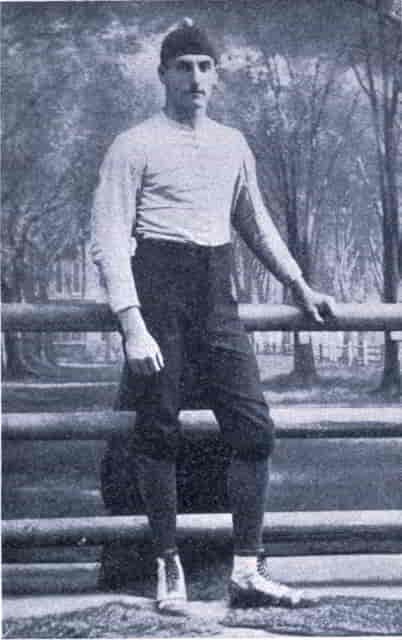 H. H. KNAPP.
H. H. KNAPP.Yale.
No matter what method of signalling be used, there is one important feature to be regarded, and that is, some means of altering the play after a signal has been given. This is, of course, a very simple thing, and the usual plan is to have some word which means that the signal already given is to be considered[Pg 130] void, and a new signal will be given in its place. There should also be some way of advising the team of a change from one set of signals to another, should such a move become necessary. It is very unwise not to be prepared for such an emergency, because if a captain is obliged to have time called and personally advise his team one by one of such a change, the opponents are quite sure to see it and to gain confidence from the fact that they have been clever enough to make such a move necessary.
TRAINING
[Pg 133]At the present advanced athletic era there are very few who do not understand that a certain amount of preparation is absolutely essential to success in any physical effort requiring strength and endurance. The matter of detail is, however, not faced until one actually becomes a captain or a coach, and, as such, responsible for the condition, not of himself alone, but of a team of fifteen or twenty men.
Experience regarding his own needs will have taught him the value of care and work in this line; but, unless he differs greatly from the ordinary captain upon first assuming the duties of that position, his knowledge of training will[Pg 134] be confined to an understanding of his own requirements, coupled with the handed-down traditions of the preceding captains and teams. When he finds himself in this position and considers what lines of training he shall lay down for his team, unless he be an inordinately conceited man he will wish he had made more of a study of this art of preparation, especially in the direction most suited to the requirements of his own particular sport.
Many inquiries from men about to undertake the training of a team have led me to believe that, even at the expense of going over old ground, it will be well in this book to map out a few of the important features of a course of training. It should go without saying that there are infinite variations in systems of this kind; but if a man will carry in mind the reasons rather than[Pg 135] the rules, he has always a test to apply which will enable him to make the most of whatever system he adopts.
He should remember that training ought to be a preparation by means of which his men will at a certain time arrive at the best limits of their muscular strength and activity, at the same time preserving that equilibrium most conducive to normal health. Such a preparation can be accomplished by the judicious use of the ordinary agents of well-being—exercise, diet, sleep, and cleanliness.
One can follow out the reasons for or against any particular point in a system rather better if he cares to see why these agents act towards health and strength.
Exercise is a prime requisite, because the human mechanism, unlike the inanimate machine, gains strength from use. Muscular movement causes disintegration[Pg 136] and death of substance, but at the same time there is an increased flow of blood to the part, and that means an increased supply of nourishment and increased activity in rebuilding. As MacLaren has expressed it, strength means newness of the muscle. The amount and quality of this exercise will be treated of later in this chapter.
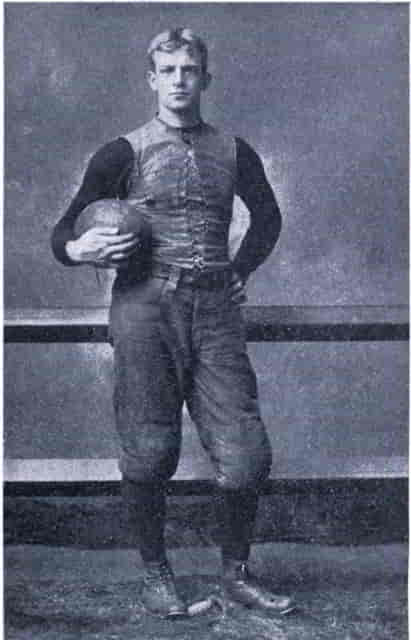 A. J. CUMNOCK.
A. J. CUMNOCK.Harvard.
In considering the matter of Diet, a captain or coach should think of this question not according to the tradition of his club, nor according to his own idiosyncrasies. He should regard the general principle of not depriving a man of anything to which he is accustomed and which agrees with him. Of course, it is advisable to do without such articles of food as would be injurious to the majority of the men, even though there might be one or two to whom they would do no harm. Men should enjoy their food, and it should be properly served. I remember once being asked my opinion regarding a certain team at the time in training, and I expressed the conviction that something was wrong with their diet. The team, as a whole, were not seriously affected, but some three or four were manifestly out of sorts. I heard the coach go over the bill of fare, and it sounded all right. I then decided to take dinner with them and see if I could discover the trouble. One meal was sufficient, for it was a meal! The beef—and an excellent roast it was, too—was literally served in junks, such as one might throw to a dog. The dishes were dirty, so was the cloth. Vegetables were dumped on to the plates in a mess, and each one grabbed for what he wanted. Some of the men might have been brought up to eat at such a table, still others were not sufficiently[Pg 138] sensitive to have their appetites greatly impaired by anything, but the three or four who were "off" were boys whose home life had accustomed them to a different way of dining, and their natures revolted. So, too, did their appetites. As it was then too late to correct the manners of the mess, I simply advised sending these men elsewhere to board, and they speedily came into shape. I cannot too strongly advocate good service at a training table. The men should enjoy their dinners, should eat them slowly, and should be encouraged to be as long about it as they will. As food is to repair the waste, it should be generous in quantity and taken when the man will not, from being over-tired, have lost his appetite. Sometimes a team is not overworked, but worked too late in the day, so that the men rush to the table almost directly from the field,[Pg 139] and fail to feel hungry, while within an hour they would have eaten with a zest. This course persevered in for several days will show its folly in a general falling-off in the strength as well as the weight of the men. To train a football team should be, in the matter of the diet at least, the simplest matter compared with training for other sports, because the season of the year is so favorable to good condition.
Crews and ball nines have oftentimes the trial of exceptionally hot and exhausting weather to face, while a football team, after the few warm days of September are passed, enjoy the very best of bracing weather—weather which will give almost any man who spends his time in out-door work a healthy, hearty appetite. In order that any captain or coach reading this book may feel that, while it offers several courses[Pg 140] of diet, it would emphatically present the fact that there is no hard-and-fast system of diet that must be religiously followed, I submit a variety of tables, showing some old as well as new school diets. None of them are very bad, several are excellent; and I don't think that a captain or coach would be called upon to draw his pencil through very many of the items enumerated.
 JEREMIAH S. BLACK.
JEREMIAH S. BLACK.Princeton.
THE OXFORD SYSTEM.—(Summer Races.)
A DAY'S TRAINING.[A]
| Rise about 7 A.M. | So as to be in chapel; but early rising not compulsory. | |
| Exercise | A short walk or run | Not compulsory (walk only, and short). |
| Breakfast, 8.30 | Meat, beef or mutton. | |
| Bread or toast, dry | The crust only recommended. | |
| Tea | As little as possible recommended. | |
| Exercise (forenoon) | None | American football men should kick, catch, and pass. |
| Dinner, 2 P.M | Meat; much the same as for breakfast. | |
| Bread | Crust only recommended. | |
| Vegetables, none allowed | A rule, however, not always adhered to. | |
| Beer, one pint | This is what Americans call ale, and not indulged in to any great extent except after a hard game. | |
| Exercise | About 5 o'clock start for the river, and row twice over the course, the speed increasing with the strength of the crew. | |
| Supper, 8.30 or 9. | Meat, cold. | |
| Bread; perhaps a jelly or watercresses. | ||
| Beer, one pint (see above). | ||
| Bed about 10. |
[A] As has been stated elsewhere, improvements have been made in diet since this table was compiled. This will also apply to the Cambridge System, page 143.[Pg 142]
TORPID RACES.
A DAY'S TRAINING.
| Rise about 7.30 A.M. | Early rising not compulsory. | |
| Exercise. | A short walk or run. | Not compulsory. |
| Breakfast, 9. | As for summer races. | |
| Exercise (forenoon). | None. | |
| Luncheon about 1 P.M. | Bread, or a sandwich. | |
| Beer, half a pint. | ||
| Exercise. | About 2 o'clock start for the river, and row twice over the course. | |
| Dinner, 5. | Meat, as for summer races. | |
| Bread. | ||
| Vegetables, as for summer races. | ||
| Pudding (rice), or jelly. | ||
| Beer, half a pint. | ||
| Bed, 10.30. |
THE CAMBRIDGE SYSTEM. Summer Races (1866).
A DAY'S TRAINING.
| Rise at 7 A.M. | ||
| Exercise. | Run 100 or 200 yards as as fast as possible. | "The old system of running a mile or so before breakfast is fast going out, except in the case of men who want to get a good deal of flesh off." |
| Breakfast, 8.30. | Meat, beef or mutton. | |
| Toast, dry. | ||
| Tea, two cups, or towards the end of training a cup and a half only. | ||
| Watercresses occasionally. | ||
| Exercise (forenoon). | None. | |
| Dinner about 2 P.M. | Meat, beef or mutton. | |
| Bread. | ||
| Vegetables—potatoes, greens | Some colleges have baked apples, or jellies, or rice puddings. | |
| Beer, one pint. | ||
| Dessert—oranges, or biscuits,or figs; | ||
| wine, two glasses. | ||
| Exercise. | About 5.30 start for the river, and row to the starting-post and back | "Most men get out for a little time before rowing back." |
| Supper about 8.30 or 9. | Meat, cold. | |
| Bread. | ||
| Vegetables—lettuce or watercresses. | ||
| Bed at 10. | Beer, one pint. |
H. CLASPER'S SYSTEM.
A DAY'S TRAINING.
| Rise between 6 and 7 a.m. | |
| Exercise. | A country walk of four or five miles. |
| Breakfast, 8. | Meat, chop or |
| Couple of eggs. | |
| Bread. | |
| Tea. ("We never drink coffee.") | |
| Exercise. | Rest for half an hour, and then a brisk walk or run. If morning exercise has not been heavy, a row on the river, terminating about 11 A.M. |
| Dinner, 12 M. | Meat, beef or mutton (broiled). |
| Egg pudding, with currants in it if desired, or other light farinaceous pudding. | |
| Ale, one glass. | |
| Wine, one glass (port), or | |
| Ale, two glasses, without wine. | |
| Exercise. | Rest for an hour, and then on the river again for a hard row. |
| "Rowing exercise should be taken twice every day." | |
| Tea. | "Tea, with toasted bread sparingly buttered, with one egg only—more has a tendency to choke the system." |
| Supper. | Not recommended. When taken, to consist of new milk and bread, or gruel, with raisins and currants and a glass of port wine in it. |
| Bed about 10. |
C. WESTHALL'S SYSTEM. For Amateurs.
A DAY'S TRAINING.
| Rise at 6 A.M., or earlier in the summer. | Cold bath and rub down. |
| Exercise. | Sharp walk about a mile out, and run home; or a row of a couple of miles at three-parts speed. |
| A dry rub-down. | |
| Breakfast (time not stated). | Meat, mutton-chop or steak (broiled). |
| Bread, stale or toast. | |
| Tea, half a pint. | |
| Exercise. | (Not stated.) |
| Dinner, 2 P.M. | Meat (as at breakfast). |
| Vegetables, none; "except a mealy potato." | |
| Bread, stale. | |
| Beer, one pint. | |
| Exercise (afternoon). | Rowing. |
| If dinner be late, luncheon to be taken to consist of Meat, beef or mutton, hot or cold. Bread. Beer, one glass. | |
| (If dinner be early, "tea with viands and liquids as at breakfast" to be taken.) | |
| Supper. | Half a pint of thin gruel, or dry toast and a glass of ale. |
| Bed. | Time not stated. |
N.B.—It is added "that the above rules are of course open to alteration according to circumstances, and the diet varied successfully by the introduction of fowls, either roast or boiled—the latter preferred;" and "it must never be lost sight of that sharp work, regularity, and cleanliness are the chief if not the only rules to be followed to produce thorough good condition."[Pg 146]
McLAREN'S SYSTEM.
A DAY'S TRAINING.
| Rise at about 7 A.M. | (Glass of cold water recommended.) | |
| Exercise. | The crew meet at 7, walk and run for four or five miles; or, in later practice, quick run of two miles. | |
| Wash and dress. | ||
| Breakfast, 9. | Meat (broiled); bread (brown) and butter; tea, two cups. "Cocoa made of the nibs boiled for four hours is better than tea for breakfast." |
|
| Smoking allowed (conditionally). "Smoking is barred, for, though here also a man's habits are to be taken into account, the subjects of training in match-boats are usually too young to have contracted a custom of smoking so inveterate as to have made tobacco indispensable to the body's internal functions, though it is not unfrequently so in older men. After breakfast is the only time allotted to the pipe." |
||
| Luncheon at 1. | Beef sandwich with half a pint of beer, or | |
| Biscuit and glass of sherry, or egg in sherry. | ||
| Exercise. | At 2.30 go out to row, and row over the whole course. "This altogether depends on the state of the crew." | |
| Wash in tepid water. | ||
| Dinner at 6 p.m. | Meat (roast, broiled, or boiled). "Any kind of wholesome meat thoroughly cooked." | [Pg 147] |
| Vegetables—"The green foods permissible contain in their list spinach—the very best of all; sea-kale, asparagus, but without melted butter; turnip-tops, young unhearted greens, but not solid cabbages; broccoli, carrots, parsnips, and cooked celery. | ||
| Turnips are also favored, and pease condemned; also cucumbers, and all salad mixtures. But boiled beet-root is good, and Jerusalem artichokes; and French beans stand next to spinach in virtue." | ||
| The course is varied daily, so that no two days together shall see the same articles on the table. | ||
| Pudding. ("Light puddings may be eaten.") | ||
| Bread. Beer, one pint. | ||
| Wine, two glasses of old port or sherry, or three of claret. Biscuits and dried fruits, as cherries, figs, etc., allowed. ("All fresh fruits are avoided.") | ||
| Jellies. ("Plain jellies are innocuous.") | ||
| Water. ("As much spring water as they have a mind to.") | ||
| Supper, 9. | Oatmeal gruel if desired. | |
| Bed at 10. | N. B.—On Sundays a brisk walk of three hours or so is taken. |
Summary.
Sleep, eight or nine hours. Exercise, about three hours. Diet, very varied.
STONEHENGE'S SYSTEM.
A DAY'S TRAINING.
| Rise at 8 A.M. | According to season and weather. |
| Cold bath. | |
| Exercise, 8.30 to 9. | Walking or running. "Let all take a gentle run or smart walk." |
| Breakfast, 9 to 9.30. | Oatmeal porridge, with meat (beef or mutton, broiled) and bread. |
| Tea or coffee, or table beer, one pint. | |
| "Tea is preferred to coffee. Cocoa is too greasy." | |
| Exercise, 9.30 to 11.30, | Billiards, skittles, quoits, or other light exercise. |
| 11.30 to 1.30. | Rowing. |
| 1.30 to about 2.30. | Running. "According to circumstances." |
| Rubbed dry and linen changed. | |
| Dinner, 2.30 to 3 or 3.30 | Meat—beef (roast) or mutton (boiled mutton occasionally), roast fowl, partridges, or pheasants (allowed), or venison (nothing better). |
| "It is generally directed that the steak or chop should be underdone;this, I am sure, is a fallacy." | |
| —Bread (ad lib.).—Puddings occasionally, made of bread,eggs, and milk, and served with preserved fruits. —Vegetables—potatoes (one or two only), cauliflowers,and broccoli (only as an occasional change). If training is protracted, fish allowed (cod or soles).—Beer, from a pint to a pint and a half.—Wine, a glass or two, port or sherry. |
|
| After dinner, until 5 or 6. | A gentle stroll or book. |
| Exercise, 6 to 7. | Rowing. |
| Supper, 8. | Oatmeal porridge with dry toast or chop, with glass of port. |
| Bed at 9 or 10. |
SYSTEM OF JACKSON AND GODBOLD.
Breakfast.—Stale or whole-meal bread, or toast, a little butter, plenty of marmalade if you like, but not jam. Bacon and eggs, or chops or steaks, with watercress if obtainable. To those who like it, a basin of oatmeal porridge, properly made, taken with pure milk about an hour before breakfast, is an excellent thing, and has a very beneficial effect upon the stomach, but it should not be taken every day. It is better to miss it every third day, or to take it regularly for a fortnight and then omit it from the next week's diet, as the too frequent use of it is rather injurious to the skin of some persons. Tea—not too strong—is better than coffee. Good ripe fruit is a capital[Pg 150] adjunct to the breakfast-table, and is an excellent article of food.
Dinner.—Lamb, mutton, beef, fowl (tender and boiled), varied by fish, of which haddock, whiting, and soles are the best, with potatoes (well boiled, and not much of them), and well-cooked vegetables, followed by a small allowance of light farinaceous pudding or stewed fruit, will be a good, wholesome diet. If you want bread, have it stale. Never eat new bread. Avoid all sauces, or made dishes, and adhere to plain food only. One thing we would particularly impress upon the reader, and that is never to take his exercise immediately before or after meals, nothing is more injurious, or likely to produce indigestion, and its concomitant evils. Some authorities abjure the use of sugar, but taken in moderation it is not injurious. A well-known champion of our acquaintance,
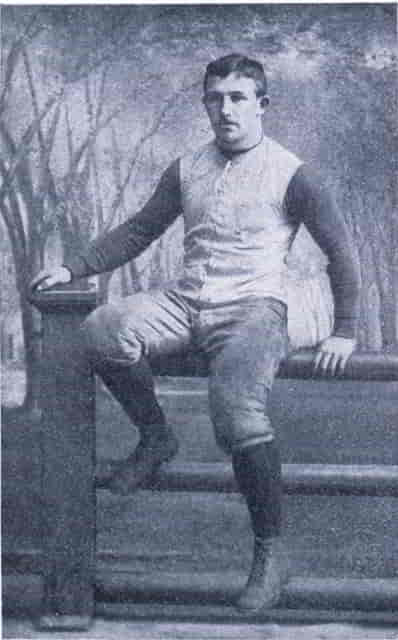 C. O. GILL.
C. O. GILL.Yale.
when in the pink of condition, was wont to amuse himself by eating the contents of a sugar basin, if one were inadvertently left near him, and without feeling any ill effects from so doing. Our readers need not follow his example, for although it might suit him, it probably would not agree with them. We have said, take sugar in moderation. Now, in this last word lies all the lectures one can give on this subject. Be moderate in all things, one might say, but above all things be moderate in the use of all edibles not actually necessary to support the increased exertion which a man in training is called upon to perform. No liquid should be taken except with, or just after meals, but we would not advise stinting the quantity too much. In summer three or four pints, and in winter two or three pints per diem would be about the quantity. Never[Pg 152] drink just before exercise, and it is better not to drink just before going to bed. In fact, the less one has to digest when retiring for sleep the better, and be sure not to drink tea late at night.
Tea, or supper, should be taken at least two hours before bedtime, and we would allow a small chop, or some light fish, bread, and very little butter, with some ripe fruit. The best meal to take before a race, and which should be taken about two hours before starting-time, is the lean of mutton-chops and a little dry toast. We have said that no liquids should be taken except at meal-times; but we do not intend to state that if a man be very thirsty he may not touch them. If he does so, it must be a very small quantity. Thirst can often be assuaged by rinsing the mouth out with cold water, and this is by far the better plan if it is efficacious.[Pg 153]
A COMMON-SENSE SYSTEM.
One author says: "Rise at six; bathe; take about two ounces (a small cup) of coffee with milk: this is really a stimulating soup. Then light exercise, chiefly devoted to lungs; a little rest; the breakfast of meat, bread, or oatmeal, vegetables, with no coffee; an hour's rest. Then the heaviest exercise of the day. This is contrary to rule; but I believe the heaviest exercise should be taken before the heaviest meal; a rest before dinner. This meal, if breakfast be taken at seven or eight, should be at one or two, not leaving a longer interval than five hours between the meals. At dinner, again meat, vegetables, bread, perhaps[Pg 154] a half-pint of malt liquor, no sweets. Then a longer rest; exercise till five. Supper light—bread, milk, perhaps with an egg. Half an hour later a cup of tea, and bed at nine."[Pg 155]
J. B. O'REILLY.
Seven o'clock is a good time for an athlete in training to rise. He ought to get a good dry-rubbing, and then sponge his body with cold water, or have a shower-bath, with a thorough rubbing afterwards. He will then go out to exercise before breakfast, not to run hard, as is commonly taught, but to walk briskly for an hour, while exercising his lungs in deep-breathing. Before this walk, an egg in a cup of tea, or something of the kind, should be taken.
The breakfast need not always consist of a broiled mutton-chop or cutlet; a broiled steak, broiled chicken, or broiled fish, or some of each, may be taken with tea or coffee.[Pg 156]
Dinner may be far more varied than is usually allowed by the trainer's "system." Any kind of butcher's meat, plainly cooked, with a variety of fresh vegetables, may be taken, with ordinary light puddings, stewed fruit, but no pastry. A good time for dinner is one o'clock.
An American athlete, when thirsty, ought to have only one drink—water. The climate and the custom in England favor the drinking of beer or claret; but, beyond question, the best drink for a man in training is pure water. After dinner, rest, but no dozing or siesta. This sort of rest only spoils digestion, and makes men feel slack and "limp."
Supper, at six o'clock, should not be a second dinner; but neither should it consist of "slops" or gruel. The athlete ought to be in bed by ten o'clock, in a room with open window, and a draught through the room, if possible, though not across the bed.
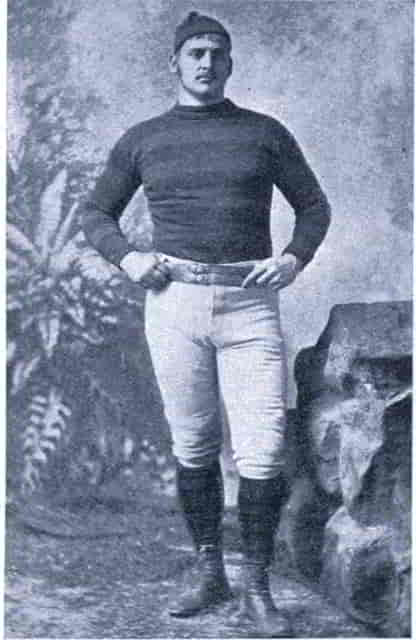 E. C. PEACE.
E. C. PEACE.Princeton.
The American football captain or coach should bear in mind, when reading these various systems, that the use of ale and port seems to be much better borne by those who live in the English climate than upon this side of the water.
Also, that stiff exercise before breakfast has not been proven advantageous to our athletes except as a flesh-reducer, and then only in exceptionally vigorous constitutions.
Also, that tea is not as popular with us as with the men who train in England.[Pg 158]
SLEEP AND CLEANLINESS.
To come to the third agent of health enumerated some pages back, Sleep. As a rule, it is not a difficult matter to see that members of a football team take the requisite amount of sleep. There are occasions, as in college, when some society event of unusual importance tempts the men to sit up late, but with such exceptions as these there is no great difficulty experienced in making the majority of the men keep good hours. And this is growing more and more simple as athletics become more general, for they take the place of much of the dissipation which was formerly the only outlet for the superabundant animal spirits of young men. In the[Pg 159] case, however, of the occasional candidate for the team who comes under the captain's eye as inclined to late hours, there must be the strictest kind of discipline shown. Such a man is the very one whose stamina will be affected after a while by lack of sleep, and that too at a time when the rest of the men are nearing the perfection of condition. Thus he will be found falling off at the very time when it is a most serious matter very likely to fill his position with a new man. Eight or nine hours sleep should be insisted upon, and that sleep should be taken with regularity. In fact, not only the sleep, but the meals and the exercise, should all be made as nearly regular, regarding hours, as possible. Men should have separate rooms, and particularly when off upon trips they should not sleep together. Plenty of fresh air should be admitted to the sleeping-room,[Pg 160] but draughts are to be avoided. This is not because every time the air blows upon a man he is liable to contract a severe cold, for the chances are against this, but because there are times when he is particularly prone to such an accident, and if he is in the habit of sleeping without regard to draughts it is not likely that he will take precautions then. If a man has, for instance, played an especially stiff game and upon a muggy and exhausting day, he will undoubtedly turn in thoroughly tired out, and perhaps still somewhat heated. Now if he, when in that state, sleeps in a draught, he will probably find himself very lame in the morning, even though he escape other more serious consequences. Just one more word of caution regarding sleep, and that is in the matter of obtaining a good night's rest just before the important match of the season. To insure this is to do much towards securing the best work of which the men are capable from the team upon the following day.
 W. HEFFELFINGER.
W. HEFFELFINGER.Yale.
First and foremost, they should not be allowed to talk about the game or the signals or anything connected with football during that evening. If possible, they should do something to entirely divert their minds from all thought of the game. Nor should they be hustled off to bed an hour or two earlier than usual. Rather ought it to be a half-hour later, for then the chances are that the men drop off to sleep immediately instead of tossing about, thinking of the exciting event of the morrow.
Finally, as to overtrained men, and that restlessness and inability to sleep that almost always comes with the worst cases of this kind. There is but one thing to do with a man when he[Pg 162] "goes fine" to this extent, and that is to sever his connection with the team for a time. If it is early in the season, there is some chance of his recuperating rapidly enough to still become serviceable. If it is late, there is no hope of this. In either case he must neither play, eat, nor spend his time with the members of the team. He can do almost anything else; he can go and watch the crew row or the ball nine play; he can study or read; he can, and in fact should, do everything possible to disassociate himself from football and violent exercise for a time, and, unless the trouble has gone too far, it will only be a couple of weeks before he will find himself coming out of it all right, and among the first signs will be good, refreshing sleep.
To pass now to the fourth of our agents for health, Cleanliness. It is fortunately[Pg 163] seldom necessary to argue the advantages of the "tub" or "sponge bath" to our football players, because they are usually accustomed to it. A daily splashing has been their ordinary habit. It is well to mention also that a fortnightly warm bath may be indulged in to advantage. But with the present understanding of all these advantages, the wisest remarks that can be made are cautions as to indiscretions in the use of baths. In the first place, one bath a day is enough, and any other should be a mere sponging and rubbing. Men who indulge in a tub in the morning and then spend another fifteen minutes in a plunge after practice in the afternoon get too much of it. Again, the habit of spending a long time under the shower every day is a mistake. It feels so refreshing after a hard practice that a man is tempted to stay[Pg 164] too long, and it does him no good. The best and safest plan is to take a light, quick sponge bath in the morning immediately upon rising, and then, after practice in the afternoon, to take just a moment under the shower, and follow it by a good rubbing. This, with the fortnightly warm bath, will be all that a man may do to advantage.
A CHAPTER FOR SPECTATORS
[Pg 167]To those who have never played the game of football, but who chance to open the covers of this book, a short explanation of the divisions and duties of the players will not be out of place. For these this chapter is added.
The game is played by two teams, of eleven men each, upon a field 330 feet long and 160 feet wide, at either end of which are goal-posts with a cross-bar.
The ball, which is like a large leather egg, is placed in the centre of this field, and each team endeavors to drive it in the direction of the opponents' goal-line, where any scoring must be done. Goals and touch-downs are the only points which count, and these can be made only as follows:[Pg 168]
A goal can be obtained by kicking the ball in any way except a punt (a certain kind of kick where the ball is dropped by a player and kicked before touching the ground) over the cross-bar of the opponents' goal. A touch-down is obtained by touching the ball to the ground behind the line of the goal. So, in either case, the ball must cross the end of the field in some way to make any score. The sole object, then, of all the struggles which take place in the field is to advance the ball to a position such that scoring is possible. A firm grasp of this idea usually simplifies matters very much for the casual spectator.
The object of the white lines which cross the field at every five yards is merely to assist the referee in determining how far the ball moves at a time; for there is a rule which states that a team must advance the ball five yards in three attempts or retreat with it twenty. If they do not succeed in doing this, the other side take possession of the ball, and in their turn try to advance it.
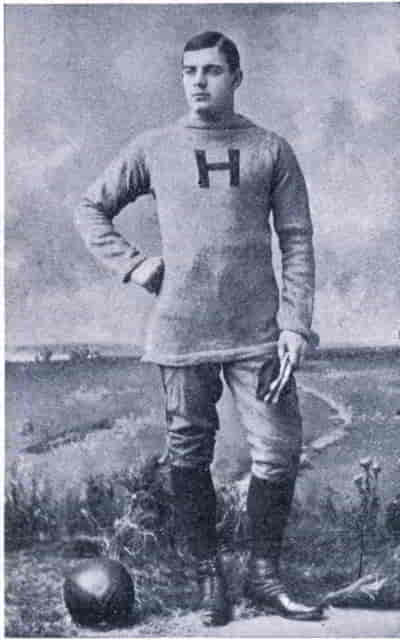 R. M. APPLETON.
R. M. APPLETON.Harvard.
There are certain rules which govern the methods of making these advances, any infringement of which constitutes what is called a foul, and entails a penalty upon the side making it.
Any player can run with the ball or kick it if, when he receives it, he is "on side"—that is, between the ball and his own goal-line. He may not take the ball if he is "off-side"—that is, between the ball and his opponents' goal-line—until an adversary has touched the ball.
Whenever a player running with the ball is held, he must cry "down," and a man of his side then places the ball on the ground and snaps it back. This[Pg 170] puts it in play, and is called a scrimmage, and this scrimmage is the most commonly recurring feature of the game.
For the purposes of advancing the ball or repelling the attack of the opponents it has proved advisable for a captain to divide his eleven men into two general divisions: the forwards and backs. The forwards, of whom there are seven, are usually called rushers, and they make practically a straight line across the field when the ball is put in play on a "down." Next behind them is the quarter-back, who does the passing of the ball to one or another of the players, while just behind him are the two half-backs and the back, usually in something of a triangle in arrangement, with the last named nearest the goal which his team is defending.
The following definitions will also aid the spectator in understanding many of[Pg 171] the expressions used by the devotees of the sport:
A drop-kick is made by letting the ball fall from the hands, and kicking it at the very instant it rises.
A place-kick is made by kicking the ball after it has been placed on the ground.
A punt is made by letting the ball fall from the hands, and kicking it before it touches the ground.
Kick-off is a place-kick from the centre of the field of play.
Kick-out is a drop-kick, or place-kick, by a player of the side which has touched the ball down in their own goal, or into whose touch-in-goal the ball has gone.
In touch means out of bounds.
A fair is putting the ball in play, from touch.
A foul is any violation of a rule.[Pg 172]
A touch-down is made when the ball is carried, kicked, or passed across the goal-line and there held, either in goal or touch-in-goal.
A safety is made when a player, guarding his goal, receives the ball from a player of his own side, and touches it down behind his goal-line, or carries the ball across his own goal-line and touches it down, or puts the ball into his own touch-in-goal.
A touch-back is made when a player touches the ball to the ground behind his own goal, the impetus which sent the ball across the line having been received from an opponent.
A fair catch is a catch made direct from a kick by one of the opponents, provided the catcher made a mark with his heel at the spot where he made the catch.
Interference is using the hands or arms in any way to obstruct or hold a player who has not the ball.
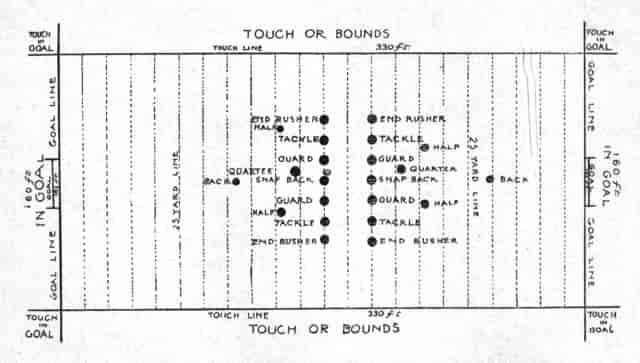
[Pg 173]The penalty for fouls and violation of rules, except otherwise provided, is a down for the other side; or, if the side making the foul has not the ball, five yards to the opponents.
The following is the value of each point in the scoring:
| Goal obtained by touch-down, | 6 |
| Goal from field kick, | 5 |
| Touch-down failing goal, | 4 |
| Safety by opponents, | 2 |
The rules which bear most directly upon the play are:
The time of a game is an hour and a half, each side playing forty-five minutes from each goal. There is ten minutes' intermission between the two halves, and the game is decided by the score of even halves.
The ball is kicked off at the beginning of each half; and whenever a goal has been obtained, the side which has lost it shall kick off.[Pg 174]
A player may throw or pass the ball in any direction except towards opponents' goal. If the ball be batted or thrown forward, it shall go down on the spot to opponents.
If a player having the ball be tackled and the ball fairly held, the man so tackling shall cry "held," the one so tackled must cry "down," and some player of his side put it down for a scrimmage. If, in three consecutive fairs and downs, unless the ball cross the goal-line, a team shall not have advanced the ball five or taken it back twenty yards, it shall go to the opponents on spot of fourth.
If the ball goes into touch, whether it bounds back or not, a player on the side which touches it down must bring it to the spot where the line was crossed, and there either bound the ball in the field of play, or touch it in with both hands, at right angles to the touch line, and then run with it, kick it, or throw it back; or throw it out at right[Pg 175] angles to the touch line; or walk out with it at right angles to touch line, any distance not less than five nor more than fifteen yards, and there put it down.
A side which has made a touch-down in their opponents' goal must try at goal.
THE END.
BLAIKIE'S HOW TO GET STRONG.
How to Get Strong, and How to Stay So. By William Blaikie. Illustrated. 16mo, Cloth, $1 00.
Mr. Blaikie has treated his theme in a practical common-sense way that appeals at once to the judgment and the understanding. A complete and healthful system of exercise is given for boys and girls; instructions are set down for the development of every individual class of muscles, and there is sound advice for daily exercise for children, young men and women, business men and consumptives. There are instructions for home gymnastics, and an easy routine of practice laid out.—Saturday Evening Gazette, Boston.
Every word of it has been tested and confirmed by the author's own experience. It may be read with interest and profit by all.—Christian Instructor, Chicago.
A successful performance, everything in the line of gymnastic exercise receiving copious illustrations by pen and pencil. The authors aim is genuinely philanthropic, in the right sense of the word, and his work is a useful contribution to the cause of physical culture.—Christian Register, Boston.
Published by HARPER & BROTHERS, New York.
The above work will be sent by mail, postage prepaid, to any part of the United States, Canada, or Mexico, on receipt of the price.
BLAIKIE'S SOUND BODIES.
Sound Bodies for our Boys and Girls.
By William Blaikie. With Illustrations. 16mo, Cloth, 40 cents. A manual of safe and simple exercises for developing the physical system.
Mr. William Blaikie's new manual cannot fail to receive a warm welcome from parents and teachers, and should be introduced as a working text-book into thousands of schools throughout the country.—Boston Herald.
A book which ought to be placed at the elbow of every school-teacher.—Springfield Union.
The directions are so simple and sensible that they appeal to the reason of every parent and teacher.—Philadelphia Press.
The influence of judicious exercise upon mind as well as body cannot be overestimated, and this will be a safe guide to this end, requiring no costume nor expensive apparatus.—Presbyterian, Philadelphia.
Published by HARPER & BROTHERS, New York.
The above work will be sent by mail, postage prepaid, to any part of the United States, Canada, or Mexico, on receipt of the price.
BOOKS FOR ANGLERS.
Fly-Rods and Fly-Tackle. Suggestions as to their Manufacture and Use. By Henry P. Wells. Illustrated. Square 8vo, Cloth, $2 50.
The book is one of great value, and will take its place as a standard authority, and we cannot commend it too highly.—Forest and Stream, New York.
An illustrated volume, elegantly presented, that will make all anglers jealous of possession until upon their shelf or centre-table.—Boston Commonwealth.
Mr. Wells's competence to expound the somewhat intricate principles and delicate processes of fly-fishing will be plain to any reader who himself has some practical acquaintance with the art discussed. The value of the author's instructions and suggestions is signally enhanced by their minuteness and lucidity.—N. Y. Sun.
The American Salmon-Fisherman. By Henry P. Wells. Ill'd. Square 8vo, Cloth, $1 00.
The success of Mr. Wells's "Fly-Rods and Fly-Tackle" has made his name familiar to thousands of American anglers. "The American Salmon-Fisherman," like the former work, is the fruit of the author's long experience and practical knowledge of this subject. The text is illustrated throughout.—Boston Traveller.
A practical, interesting guide to the sport of salmon-fishing. The tyro will read it through profitably; the old hand will not be offended by it as too elementary. The author is alert and companionable.—Atlantic Monthly, Boston.
Published by HARPER & BROTHERS, New York.
Either of the above works will be sent by mail, postage prepaid, to any part of the United States, Canada, or Mexico, on receipt of the price.
Dr. C. C. ABBOTT'S WORKS.
Upland and Meadow. A Poaetquissings Chronicle. By Charles C. Abbott, M.D. 12mo, Cloth, $1 50.
Delightful reading for students and lovers of outdoor nature.... Here the author discourses with the greatest charm of style about wood and stream, marsh-wrens, the spade-foot toad, summer, winter, trumpet-creepers and ruby throats, September sunshine, a colony of grakles, the queer little dwellers in the water, and countless other things that the ordinary eye passes without notice.... The book may be heartily commended to every reader of taste, and to every admirer of graceful and nervous English.—Saturday Evening Gazette, Boston.
Waste-Land Wanderings. By Charles C. Abbott, M.D. 12mo, Cloth, $1 50.
There is a freshness about his anecdotes of fishes and birds, and his descriptions of unfamiliar scenery, that must make the book delightful to every lover of similar sports. To those who have not the leisure nor the enterprise for similar expeditions the reading of it will charm many an idle hour, besides imparting in the most agreeable manner possible a large fund of interesting information.—St. Louis Republican.
It is a charming book, introducing the reader to the interesting guests and dwellers in the forests, upon the downs, and by the river-side. All lovers of nature will find an abundant source of instruction and pleasure in it.—Zion's Herald, Boston.
Published by HARPER & BROTHERS, New York.
Either of the above works will be sent by mail, postage prepaid, to any part of the United States, Canada, or Mexico, on receipt of the price.

